

The Student Experience Arc of Learning Guide
Grades 1-12
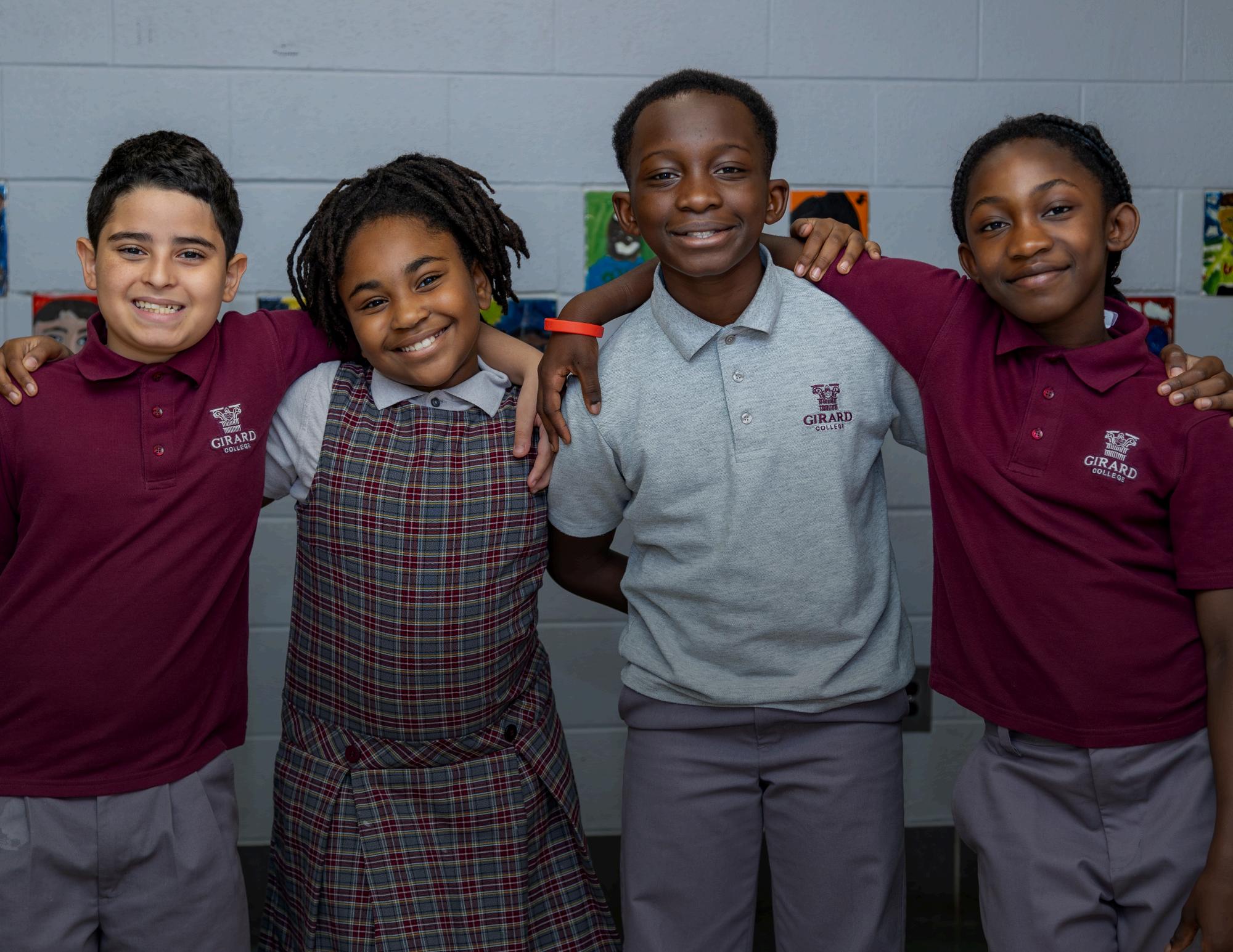
Girard College is a full-scholarship boarding school that fosters intellectual curiosity, social development and emotional growth in academically focused students from underserved communities. We ensure every student the opportunity and the means to achieve excellence and preparation for advanced education through purposeful academic and residential programs.
INTRODUCTION
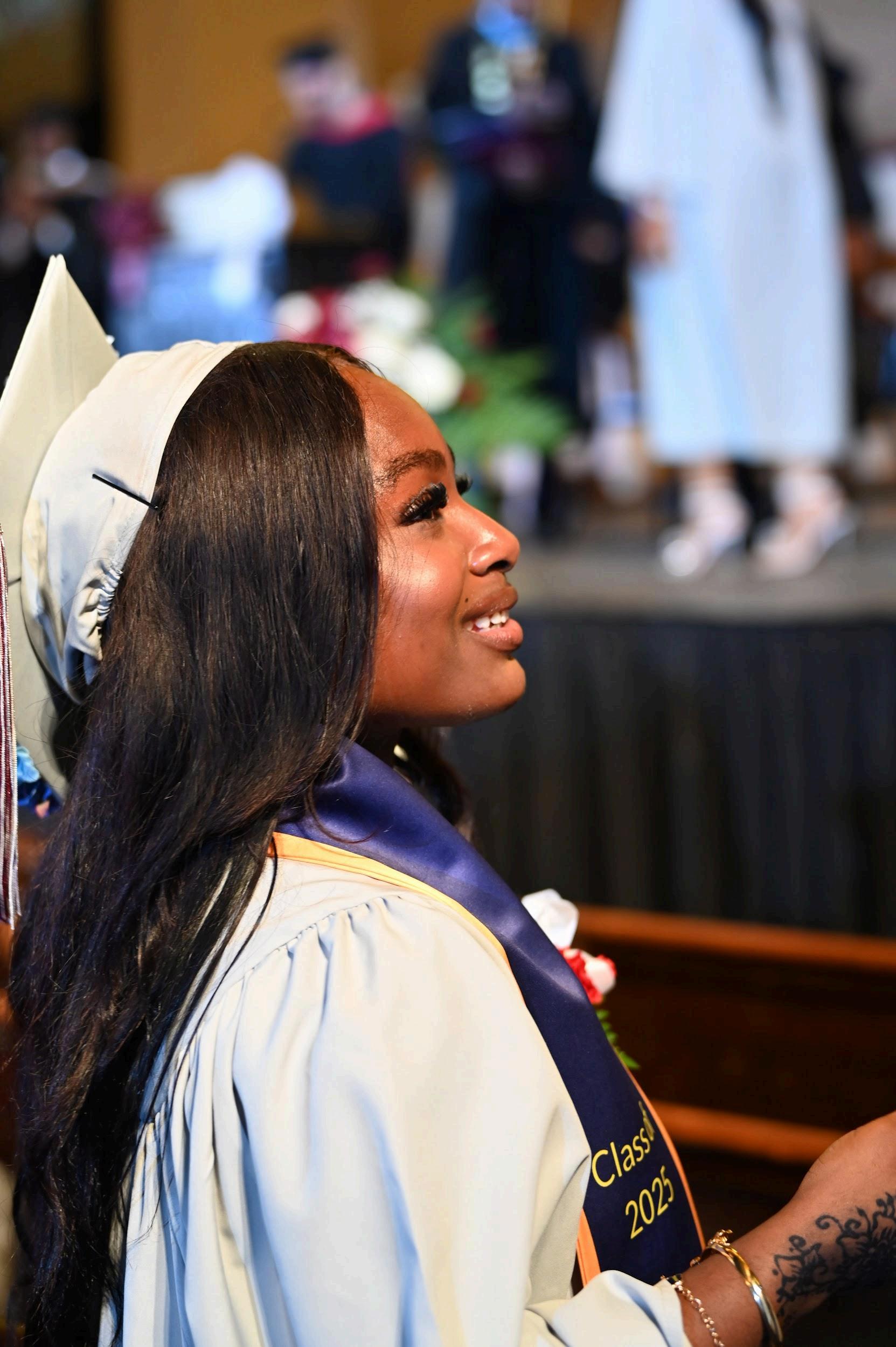
The Girard College Student Experience Arc of Learning Guidebook for Grades 1–12 sets a dard for what students will learn at each grade level, providing families, the d the Office of Student Experience with a unified vision to guide programming ulum. This guidebook provides learning profiles for each grade, aligning both and residential education to ensure that every Girard student is fully equipped ss beyond graduation. By outlining key academic milestones in subjects such as glish language arts, science, and social studies, and integrating career readiness, ondary preparation, and essential life skills, the guidebook frames a more holistic hat Girard students need to be successful in school and life. This guidance the National Common Core Standards, PA Common Core Academic Standards, mic Standards for Career Education and Work, Collegeboard and draws from esources like the Casey Life Skills Indicators, Common Sense Media’s Digital p program, the YMCA Swim Curriculum, the Truth Initiative, and the Ask Listen gram, to support our life skills objectives and provide students with the tools d to succeed in both college and career.
redited institution through the Middle States Association Commissions on ry and Secondary Schools, Girard College is committed to meeting and g rigorous academic standards and ensuring robust life skills for all students. this requires the collaborative efforts of students, families, teachers, residential and administrators, all working together to ensure the best possible outcomes nts. Grounded in the educational philosophy of Stephen Girard, the program es rigorous, joyful, and transformative learning experiences that prepare for post-secondary success. This is all underpinned by our core values and the of our learning environment, which include small class sizes, data-informed n, personalized learning, timeless and modern resources, global perspectives, century readiness, ensuring we are shaping well-rounded, future-ready students who will thrive in an ever-changing world.
Core Values
Our core values structure and inform our expectations for all members of the Girard College community. Each of these values is supported by a set of belief statements that guide our interactions every day.
Integrity
● Be honest and trustworthy
● Do the right thing in all circumstances
● Honor your commitments
● Speak up for the truth and against injustices
Responsibility
● Be accountable for your decisions and actions
● Be reliable and communicate with sureness
● Engage in your learning and take ownership of your actions
● Fulfill your duties and demonstrate stewardship
Respect
● Acknowledge your feelings and those of others
● Appreciate differences and display a positive attitude through challenges
● Demonstrate courtesy, gratitude and thankfulness
● Recognize your self-worth while treating others with dignity and understanding
Compassion
● Be of service as a citizen of the community
● Build mutually supportive relationships
● Demonstrate kindness and caring toward others
● Seek to understand and empathize with others
Courage
● Develop self-discipline
● Persevere through adversity and remain steadfast in pursuit of your goals
● Reframe setbacks as opportunities for growth
● Stand up for what you believe and express self-advocacy

ELEMENTARY MIDDLE SCHOOL
At our elementary level, we are dedicated to preparing young minds and hearts for a lifelong love of learning. For students in Grades 1 through 4, we focus on providing individualized attention and an engaging curriculum designed to foster a strong foundation in reading proficiency and comprehension, as well as build essential math skills and conceptual understanding. Our approach emphasizes nurturing a spirit of curiosity and joy through hands-on experiences, diverse opportunities, and asset-based programming in the arts. By creating a supportive and dynamic learning environment, we aim to inspire each child to explore their potential and develop a deep passion for learning. Students participate in Phonics, English/Language Arts (ELA), Math, Science, Social Studies, W.I.N., Library, Art, Music, Physical Education and Health.
At our Middle School, we focus on guiding students in Grades 5 through 8 as they transition to greater independence and prepare for their future endeavors. The middle school experience is structured to support this development with a robust curriculum and specialized teaching teams—four core teachers for Grades 5 through 8. We offer acceleration opportunities to prepare students for Algebra readiness by 8th grade and introduce them to biliteracy in French or Spanish. Our program emphasizes leadership and character development through restorative circles a vibrant Student Council and leadership development opportunities like Philadelphia Outward Bound ADD

Grading Scale & Grade Po
Girard College uses a letter gra students, while GPA calculatio standard Grade Point Average and Dual Enrollment courses in
Letter Grade Grade Ran
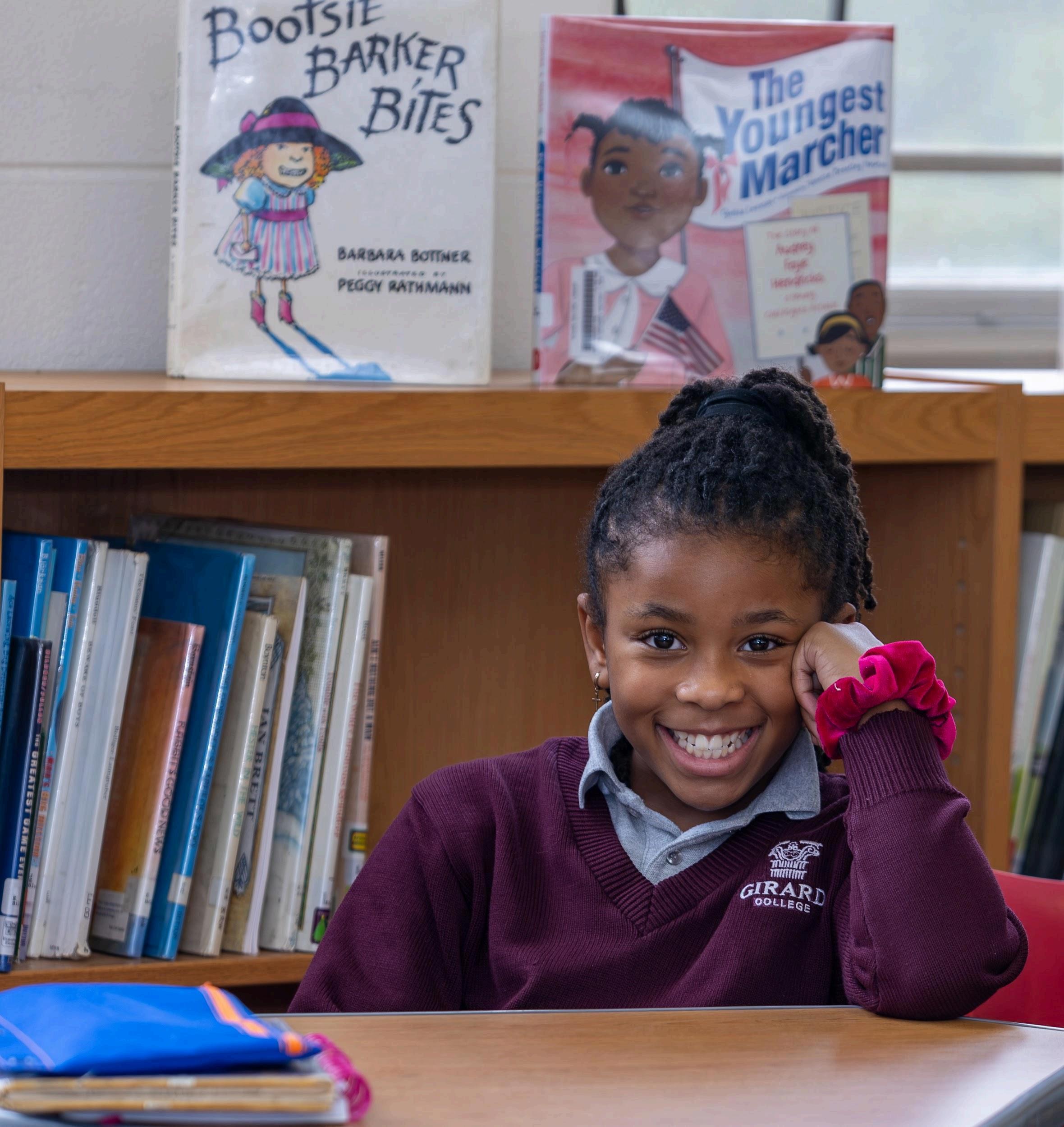
GRADE 1
ELA
Learning to Read: Learn basic reading skills like holding a book, recognizing sounds, and understanding words. Recognize words quickly, understand their meanings, and grasp what’s read Read regularly to improve speed and smoothness. Work with others to practice reading and discuss stories.
Writing: Learn to write for various reasons. Practice handwriting, spelling, and grammar Write every day for different tasks. Improve writing by drafting, reviewing, and editing
Speaking & Listening: Engage daily in one-to-one, small group, and whole class conversations Establish skills of collaborating, being a good listener, taking turns, and supporting ideas with facts Ask questions to understand better.
Language: Use correct grammar and punctuation. Learn new words by reading and listening. Use surrounding words to figure out meanings Encounter and understand new vocabulary often.
Math
Counting & Place Value: Learn to read, write, and understand numbers up to 120 and later up to 1,000. Understand tens, ones, and hundreds in numbers and use symbols like < , > , and = to compare numbers.
Addition & Subtraction: Add and subtract numbers up to 100, solving problems using drawings and models
Fractions: Split shapes into equal parts and understand how dividing shapes into more pieces makes each piece smaller.
Measurement: Compare the lengths of objects using standard tools like rulers and estimate sizes with different units (inches, feet, etc.).
Mathematical Practices: Help students solve problems with support and enrichment Foster collaboration and peer learning Use routines to build student confidence in math.
Financial Literacy: Learn that money is something people earn and use to make choices about what to buy, save, or share. Begin to understand the value of coins and dollars, how to count and compare money, and how people use money to meet needs and wants.
Science
Life Science: Identify plant and animal parts that help them survive and grow. Design models to show how body parts work together for survival. Group plants and animals by physical traits like shape and color Compare young plants and animals to their parents Investigate changes as plants and animals grow. Observe and compare life cycles of different organisms.
Physical Science: Investigate how vibrations create sound. Learn how light reflects off objects for us to see. Understand that light travels through space and can be redirected with mirrors. Explore how different materials affect light Design devices that use light or sound for communication.
Earth and Space Science: Observe the stars, moon, and sun to identify predictable patterns. Understand that objects in the sky move in cycles. Collect and organize weather data to track daily and long-term weather changes
Social Studies
Civics: Understand why rules are important for everyone’s safety and fairness. Demonstrate how to behave responsibly in a community by respecting others and following rules Learn how family, school and community groups are organized to make decisions for the greater good of the group
Economics: Distinguish between needs as things we must have to live and wants as things it would be nice to have. Understand that people use money to buy goods and services in markets. Understand that people and communities work to provide for themselves. Learn that people earn money by working.
Geography: Learn about simple tools like maps and globes to understand locations Understand where you are in relation to the world around you. Learn about the places where people live, work, or have fun in the community
History: Understand how things change over time by looking at the past and present. Learn about important documents or objects that tell the story of the community. Recognize how different people or groups help improve the community
Career Education & Work
Career Awareness & Exploration: Learn that people do many different jobs and prepare for them in different ways
Employability Skills: Begin to work with others, talk clearly, and understand how to be safe and responsible at school and online.
Growth & Advancement: Learn how to set simple goals, try their best, and practice new things to get better
Personal Interests & Career Planning: Start to notice what they’re good at and learn that school helps them for future jobs.
Lifeskills
Self Care: Can shower (including drying off), undress/dress themselves and use the toilet independently. Know basic hygiene routines (brushing teeth, washing face, washing hands and using a tissue (nose blowing) Know their private areas, safe touch and learn to say “no” to unwanted touch
Daily Living: Can strip/change and make a bed with minimal assistance. Can unpack their laundry bundle, put the right clothes on hangers and separate clean clothes from dirty clothes Can help with sweeping, vacuuming, wiping surfaces, watering plants or feeding a pet. Can help with meal prep, meal clean up and packing their own lunch Can begin to understand the concept of time and manage their own time in certain activities Know the phone number of their “adult ” Learn water acclimation/skills (pool safe water habits, comfort with underwater exploration and how to exit a body of water if they fall in)
Communication: Can engage in basic conversations and make friends. Can understand and practice taking turns in games and activities Will ask for help when needed and will talk to a trusted adult when upset.
By the end of 1st grade at Girard College a student will be able to say:
“I can use objects to group tens and ones to solve a simple addition equation.”
“I can recognize the "c" sound, "a" sound, and "t" sound to say the word “cat.”
“I can create a model of a plant with roots, stem, and leaves to show how these parts help the plant get water and sunlight.”
“I know that we use money to buy things and get services.”
“I tried an activity and shared what I liked best and why.”
“I can make my bed with minimal assistance.”
School & Study Life: Can follow directions and complete tasks independently Can identify their homework folder, homework assignments and supplies needed to complete it. Learn to balance tech use, be safe, responsible and respectful online and listen to their feelings when using tech.
Social Relationships: Can use polite words and good manners (saying please and thank you). Can
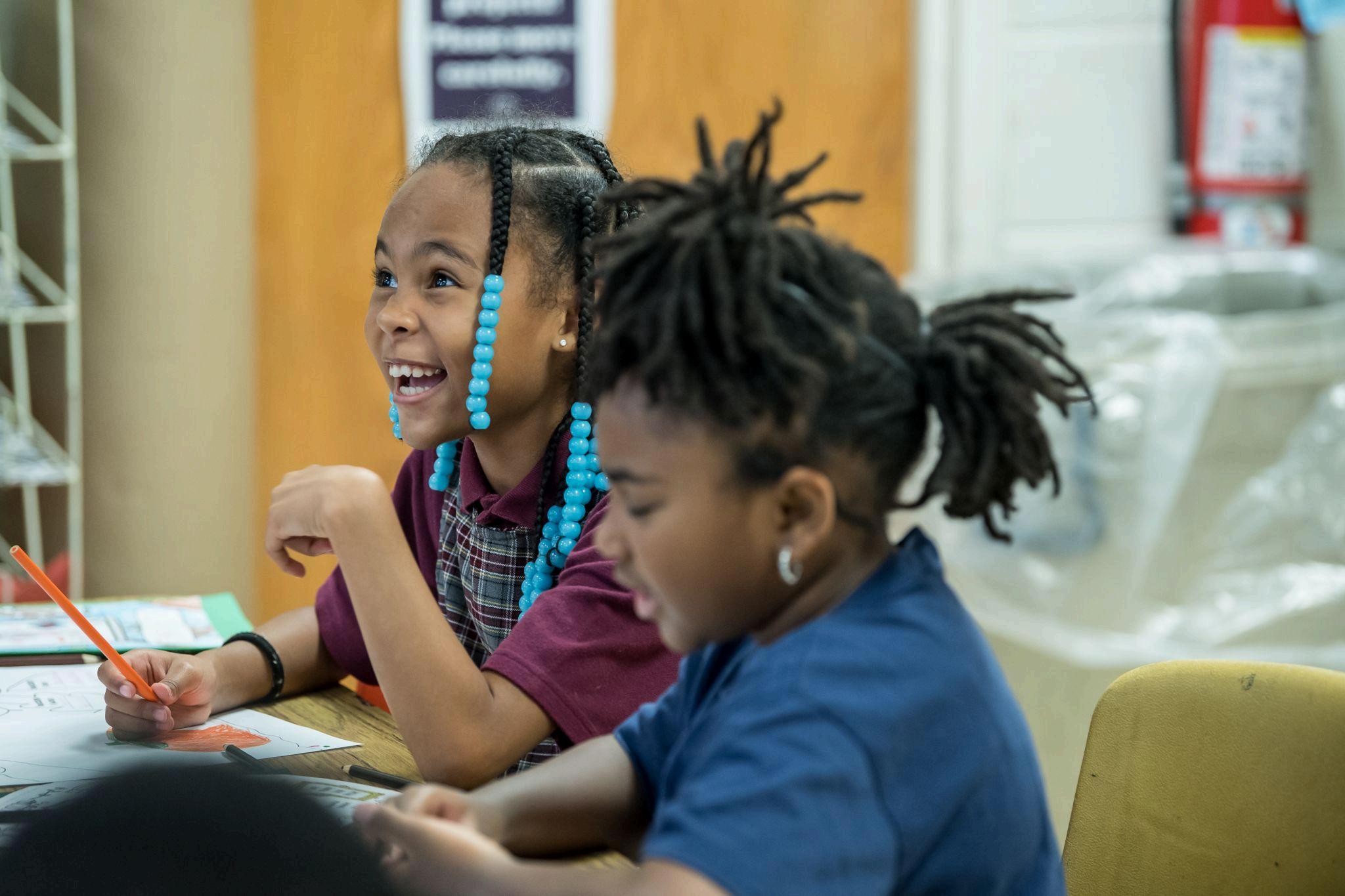
GRADE 2
ELA
Learning to Read: Use phonics to decode words and understand their meanings. Read accurately and fluently. Identify the main idea and key details of a story Ask and answer questions about the text. Describe how events are connected and how characters respond to challenges Discuss different character viewpoints Use text features like titles, headings, and pictures to find important information. Learn new words using context clues
Writing: Write to tell a story, share an opinion, or explain something Focus on improving handwriting, spelling, punctuation, and grammar. Write daily for various tasks and practice brainstorming, drafting, reviewing, and revising for clarity.
Speaking & Listening: Engage in 1-1 and group conversations, listening and sharing ideas Recount key details from a story. Ask and answer questions to gather more information Tell a story with clear, organized details.
Language: Use proper grammar and punctuation for clear communication. Clarify new words using context clues or asking for help. Learn new words through reading, writing, and conversation, and encounter common words regularly.
Math
Place Value & Number Comparison: Understand numbers up to 1000, focusing on hundreds, tens, and ones. Compare and express them in different forms like expanded form or number names.
Addition & Subtraction: Add up to four two-digit numbers, breaking down larger numbers by hundreds, tens, and ones
Fractions: Split shapes into two, three, or four equal parts and understand that different shapes can have equal parts.
Measurement: Measure and estimate lengths, comparing them using various units and use addition and subtraction within 100 to solve word problems using lengths.
Mathematical Practices: Help students persist in problem-solving and find alternative solutions Encourage safe discussions for sharing and critiquing ideas. Promote self-monitoring of progress using patterns and properties.
Financial Literacy: Learn that people make decisions about money based on goals, needs, and wants. They explore how to save, plan ahead, earn money in different ways, and safely keep their money. They use math to count, compare, and keep track of money, and think about how to make smart choices.
Science
Life Science: Learn how seeds spread and the different ways they travel. Test if plants need sunlight and water to grow. Compare how plants from different places have different needs for water, sunlight, and soil
Physical Science: Classify matter by its properties, such as size, shape, and whether it’s a solid, liquid, or gas Test how heat changes materials, like turning a solid to liquid and a liquid to solid Understand which changes can be reversed (like freezing water) and which cannot (like baking a cake). Test materials to see if they work for specific tasks. Design solutions to solve problems and compare them with others Disassemble and rebuild objects using the pieces.
Earth and Space Science:
Compare ways to prevent land erosion from wind or water Observe how Earth changes quickly (like volcanoes) or slowly (like mountains) Identify patterns in landforms and bodies of water. Create models of land and water shapes.
Social Studies
Civics & Government: Learn about good citizenship, community problems, and solutions. Understand the role of community leaders and how people contribute to history and culture. Participate in class elections, predict the roles of community leaders, and propose solutions to local problems.
Economics: Explore the difference between natural resources and man-made goods, and how they impact food, clothing, and shelter. Understand how economic decisions are made, the role of the government in the economy, and how workers contribute to the community Learn about income, profits, and business economics.
Geography: Learn to use maps, a map grid, key and compass to locate places, trace routes, and understand geographic features Compare rural, suburban, and urban areas and explore how natural features affect where people live and work.
History: Analyze Native American cultures over time, recognize factors influencing community changes, and use historical documents and photos to understand the past. Learn about individuals and groups who improve their communities.
Career Education & Work
Career Awareness & Exploration: Explore jobs on campus and in their neighborhood and understand that people work for different reasons
Employability Skills: Practice teamwork, respectful communication, managing time, and using technology safely.
Growth & Advancement: Understand that learning new things and working hard helps them grow and reach goals.
Personal Interests & Career Planning: Talk about what they like to do, what they’re good at, and how it might connect to future careers
Lifeskills
Self Care: Can independently shower, undress/dress themselves including zipping, buttoning and tying shoes and managing bathroom needs. Know hygiene routines (managing hair and good hygiene after toileting) Understands personal safety, body rules and boundaries Know what to do in an emergency (call 911, evacuate, etc.) and how to clean a minor wound and apply a bandaid. Know their address and can explain where they live.
Daily Living: Can neatly make the bed and strip/change bedding with support. Can sort clothes by color and load the washing machine (with supervision), fold or hang, and put away their own clothes Can sweep, vacuum, wipe surfaces, tidy up and keep their own space organized Can set the table, help with meal prep (washing food or mixing ingredients), clean up meals and pack their own lunch with healthy options Can understand the concept of time (seconds, minutes, hours, days) using a calendar, clock or a watch, and develop a sense of routine. Learn what is vaping, drugs and alcohol and the effects on the body. Learn fundamental water movement/aquatic skills (body position and control, directional change, forward movement and basic self rescue)
Communication: Can express needs and feelings clearly, listening attentively and engaging in respectful conversations Learn basic social graces (greetings and covering coughs/sneezes)
By the end of 2nd grade at Girard College a student will be able to say:
“I can write the number 287 in expanded form 200 + 80 + 7 and in word form two hundred eighty-seven.”
“I can write a neat sentence with correct punctuation and a capital letter at the start.”
“I know that water is a liquid, ice is a solid, and steam is a gas.”
“I can locate places on a map using a map grid, map key, and compass rose.”
“I know the community workers on campus like cafeteria workers and custodians.”
“I can safely exit the pool if I fall in.”
School & Study Life: Can make age-appropriate choices, like selecting a preferred activity or club and understanding the consequences of those choices Can complete assigned tasks, taking ownership of their actions and checking their work. Learn how to be a digital citizen, what to share online (digital footprint), what to do if someone is mean to them online and giving credit for other people’s work.
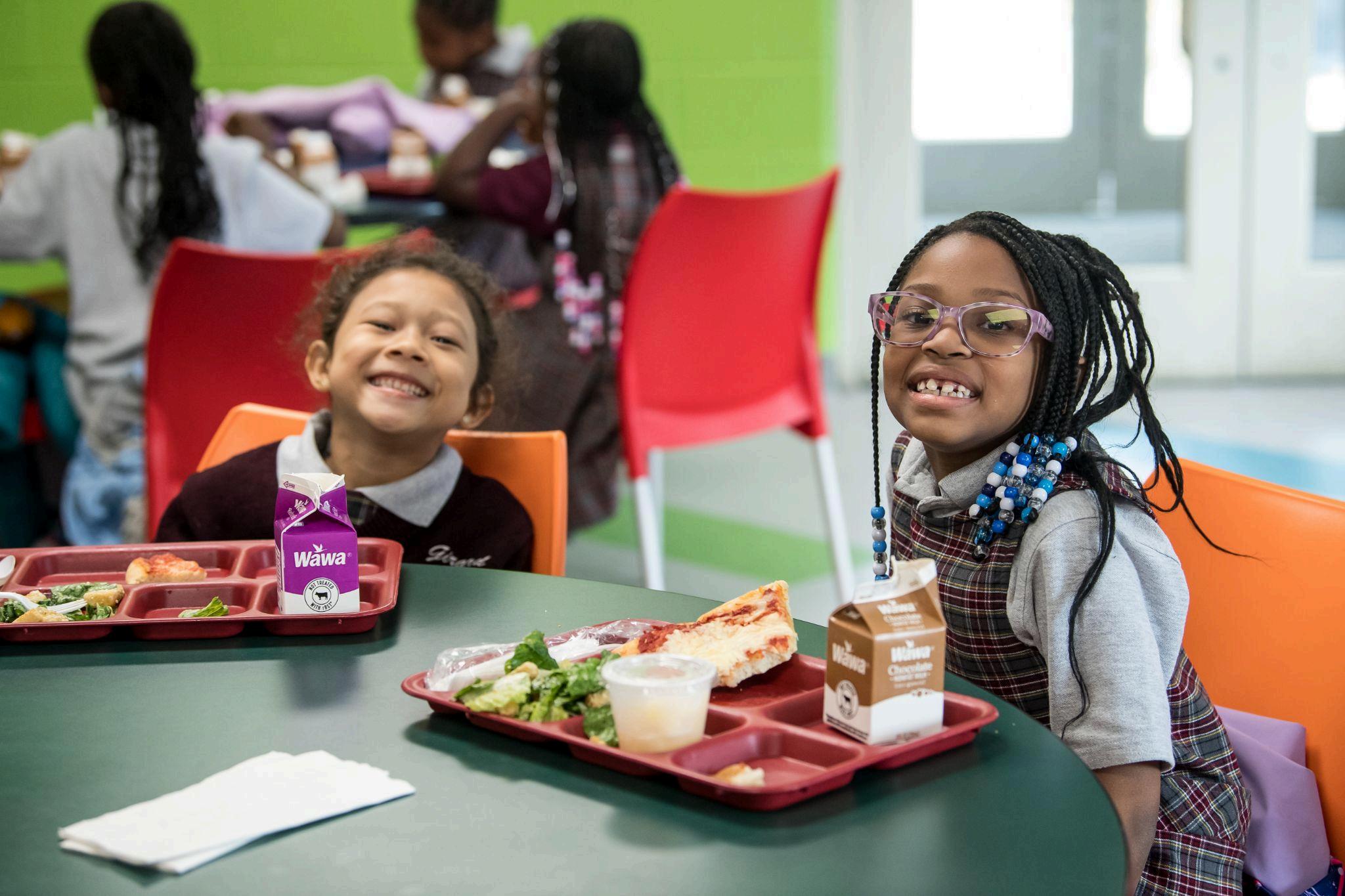
GRADE 3
ELA
Learning to Read; Reading to Learn: Use phonics and word skills to read accurately and understand meanings. Read regularly for fluency Identify the main idea and key details in a story Ask and answer questions about the text Explain how events and characters’ actions connect Discuss the author’s point of view. Use text features to locate key information. Understand literal and nonliteral meanings.
Writing: Write for different purposes, such as storytelling or explaining. Focus on handwriting, spelling, punctuation, and grammar. Write daily for various tasks. Use the writing process to improve work.
Speaking & Listening: Engage in discussions, sharing ideas and listening to others Ask and answer questions to gather more information. Share stories or experiences clearly
Language: Use proper grammar and punctuation for clarity Use context clues to understand new words. Learn and use new vocabulary through reading, speaking, and listening.
Math
Place Value: Understand how numbers are made up of hundreds, tens, and ones Compare and write numbers up to 1000.
Adding & Subtracting: Use place value to add and subtract up to four two-digit numbers Understand how to add and subtract hundreds, tens, and ones
Solving Problems: Solve word problems within 100, using addition and subtraction, including problems with three numbers.
Fractions: Split shapes into equal parts like halves, thirds, and quarters.
Measurement: Measure lengths using tools like rulers and compare different units.
Relating Length to Addition & Subtraction: Use addition and subtraction to solve length problems
Mathematical Practices: Guide students to manage frustration and find alternative solutions. Foster safe discussions for sharing and critiquing ideas Encourage self-monitoring using patterns and properties.
Financial Literacy: Introduce financial goal setting and opportunity cost. Discuss how life circumstances and how needs and wants impact spending choices. Learn about financial products like savings accounts Understand how people earn money.
Science
Life Science: Create models to show similarities in life cycles of different organisms. Analyze data to see how traits are inherited and vary within groups. Compare inherited traits, environmental traits, and traits resulting from both Show how environmental changes can affect survival, movement, or extinction of organisms. Explain how some rocks and minerals contain evidence of past organisms.
Physical Science: Investigate how different factors affect object movement. Explain why objects stay still or move when pushed or pulled. Demonstrate how forces change speed or direction of objects Measure and represent object movement in different ways Identify patterns in object motion to predict future movement Show how objects in contact can push or pull on each other.
Earth and Space Science: Record and analyze weather data to identify patterns and make predictions. Display and interpret weather data to predict future conditions
Social Studies
Geography: Develop map-reading skills, including using a map grid, key, and compass rose. Identify key geographic features such as the equator, prime meridian, hemispheres, oceans, and continents. Locate countries, states, and communities on maps, and understand how physical features, climate, and natural resources influence human activities
History: Explore the history of immigration to the USA, examining reasons for and effects of immigration. Study cultural diversity and the contributions of groups to American society. Learn about individuals who improved their communities and the responsibilities of citizenship
Economics: Understand goods and services, market transactions, and the role of scarcity in decisions. Explore the principles of supply and demand and how they affect prices Learn about budgeting, saving, and the impact of global trade on local economies
Civics: Investigate the roles and responsibilities of government and community services. Learn about civic participation and how individuals can contribute to their communities Explore the structures of local and state governments and the significance of voting and civic engagement
Career Education & Work
Career Awareness & Exploration: Learn that there are many kinds of jobs and that people prepare for them in different ways
Employability Skills: Practice working in groups, communicating clearly, using technology safely, and managing time.
Growth & Advancement: Set simple goals, try new skills, and work hard to grow.
Personal Interests & Career Planning: Notice personal interests and strengths to begin thinking about future jobs
Lifeskills
Self Care: Can independently shower, undress/dress themselves including choosing appropriate clothing (for activity) and managing all aspects of toileting including maintaining continence (ability to control functions until appropriate time) Know hygiene routines (including using lotion and basic nail care). Understand healthy relationships. Learn about online safety, pedestrian safety and traffic safety and know who to tell if something feels wrong.
Daily Living: Can manage a chore list of age appropriate tasks (making their bed, strip/change bedding (may need support), their laundry, tidy their own space, and basic cleaning) Under supervision, can prepare simple meals like sandwiches and snacks Can wake up using an alarm, managing their own morning routine. Learning the dangers of vaping, drugs and alcohol and the benefits of healthy choices Can use simple tools like a screwdriver under supervision Learn water stamina/stroke development (basic stroke techniques, rotary breathing, integrated arm and leg action and continuing self rescue skills).
Communication: Can express needs and opinions clearly, listen attentively and engage in respectful conversations. Talk about feelings in a calm way. Know their address and can explain how to get home Learn basic social graces (personal space and asking permission)
By the end of 3rd grade at Girard College a student will be able to say:
“If I cut a pizza into 4 equal slices, I know that each slice is a fourth (1/4) of the pizza.”
“I can read a story, share the main idea and support my answer with key details from the story.”
“I can create a bar graph showing monthly rainfall and use it to predict what the weather will be like next month.”
“I can tell you four ways to have a voice in my community.”
“I know what my strengths are and things I like to do.”
“I know how to cross the street safely at the crosswalk ”
School & Study Life: Can set small achievable goals and work towards them. Can make age-appropriate choices about daily activities, with guidance Can take ownership of their belongings, complete assigned tasks on time, and learn from mistakes. Help others in the classroom, dorm or at home. Learn how to take responsibility as a digital citizen and member of the online community, the importance of strong passwords, the effects of posting online and using hurtful language and recognizing altered photos/videos.
Social Relationships: Can share, take turns and interact positively with peers and adults Think about how actions affect others Return things that aren’t theirs Can work alone or with a team Develop the
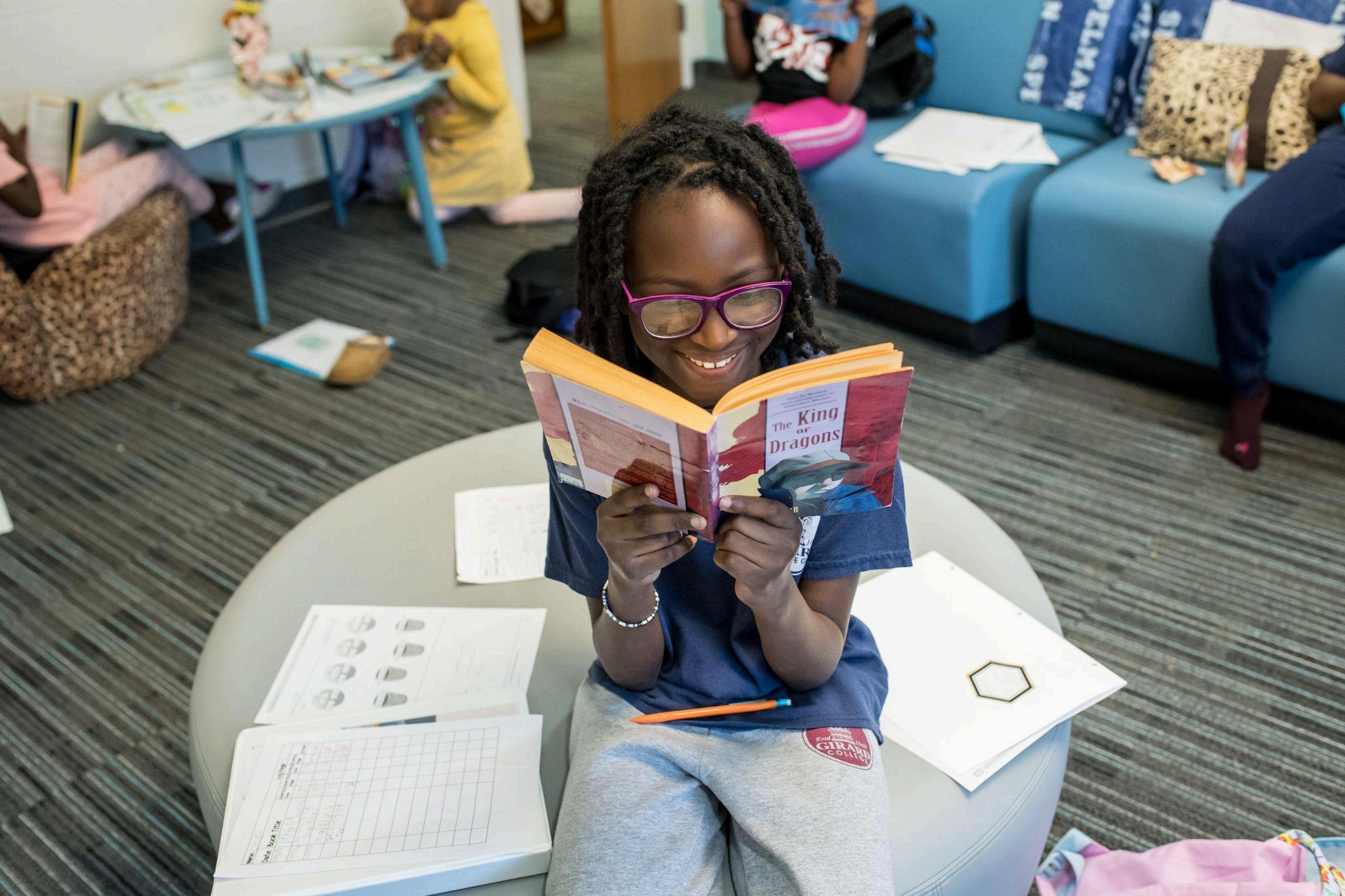
GRADE 4
ELA
Reading to Learn: Learn new words, facts, and ideas from texts Read and discuss a variety of texts from different genres to understand and combine reading skills with knowledge. Practice decoding unfamiliar words and interact with text through close reading, analysis and interpretation.
Writing: Write routinely for various purposes (research, reflection, and revision), focusing on handwriting, spelling, punctuation, and grammar. Write daily and use and cite information gathered from evaluating sources to respond analytically. Focus on the writing process to improve work
Speaking & Listening: Engage in discussions, build upon the ideas of others and ask and answer questions to deepen understanding, and collaborate with peers
Language: Apply grammar and punctuation rules to communicate clearly. Determine the meaning of new words using context clues or by asking for help. Learn how words are related and their meanings in different contexts, acquiring new words through reading, listening, and speaking.
Math
Numbers & Operations: Work with multi-digit numbers, compare and round them, and perform arithmetic. Compare, order, and connect fractions to decimals
Algebraic Concepts: Solve problems using equations, recognize factors, and identify patterns.
Geometry: Identify and classify shapes by their sides and angles.
Measurement, Data, and Probability: Solve measurement problems, convert units, and interpret data, including fractions, with graphs.
Mathematical Practices: Use tools to solve problems, share reasoning, and recognize patterns to solve math efficiently.
Financial Literacy: Understand financial goals and opportunity costs, like saving for a big item instead of small purchases. Discover how education and experience impact earnings Explore how people earn money through side jobs or businesses. Understand payment methods and the difference between spending from an account or borrowing. Learn how taxes apply to purchases
Science
Life Science: Describe how the internal and external parts of plants and animals help them survive, grow, and reproduce.
Physical Science: Investigate the forces between magnets and how they work together Use magnets to move objects without touching them Explore conductors and insulators. Build and explain circuits, including open and closed ones. Make and test electromagnets Investigate how energy transfers through sound, light, heat, electricity, and magnets Understand how energy causes motion.
Earth and Space Science: Use rock patterns and fossils to explain how landscapes change over time. Observe weathering and erosion from water, ice, wind, or plants. Analyze maps to describe Earth's features Identify water environments in Pennsylvania. Use fossils to learn about past life Explain how landforms and environments change over time.
Social Studies
Geography: Develop map-reading skills, including interpreting physical and special-purpose maps. Understand the relationship between geography and human activities. Explore the concept of population density and its impact on urban and rural life
History: Examine key historical events and figures that have shaped the US. Analyze the experiences and contributions of various cultural groups and understand the significance of historical sites and artifacts Explore the evolution of communities over time.
Economics: Learn about economic concepts such as supply and demand, mass production, and the role of government in the economy Investigate the economic activities of different regions and understand how geography influences economic development. Explore the impact of technological advancements on industry and agriculture.
Civics: Study the structure and functions of government at local, state, and national levels. Understand the principles of democracy, the importance of laws, and the rights and responsibilities of citizens Explore the significance of civic participation and community involvement.
Career Education & Work
Career Awareness & Exploration: Explore how people prepare for different careers and learn about jobs in the community
Employability Skills: Work with others, understand different viewpoints, and use the internet responsibly
Growth & Advancement: Reflect on skill improvement and practice setting goals to learn new things
Personal Interests & Career Planning: Connect personal interests to potential careers and learn how to find information about jobs.
Lifeskills
Self Care: Can independently bathe including their hair and choosing appropriate clothing (for occasion and weather). Know hygiene routines (including using deodorant, brushing teeth twice a day, flossing and feminine hygiene) Understand body changes and sexual harassment prevention Understand basic safety rules and potential dangers. Learn basic self-defense techniques. Can handle minor injuries or illnesses. Know the phone number of at least two closest relatives or emergency contacts
Daily Living: Can manage a list of age appropriate tasks and household/dorm chores (strip and change bedding, laundry (including detergent), cleaning, sweeping, dusting, putting things away, organizing belongings, making a shopping list, taking out trash and basic yard work). Understand basic kitchen safety (wash hands, appropriate clothing, tie hair back, wipe spills immediately) and how to plan a balanced and nutritious meal. Can make simple meals or snacks like scrambled eggs, hot dogs or by following a simple recipe. Learn to manage their time effectively and meet deadlines. Learn the dangers of vaping, drugs and alcohol and practicing saying “no ” Learn basic table manners and sewing skills. Develop confidence and skills to ride a bicycle safely.
Communication: Can express needs and opinions clearly, listening attentively and engaging in respectful conversations. Can analyze information and form their own opinion.
By the end of 4th grade at Girard College a student will be able to say:
“I can convert 36 inches into 3 feet, since 12 inches = 1 foot.”
“After drafting a story, I use the writing process to revise it and make it better ”
“I can build and explain both series and parallel circuits, showing how electricity flows in each ”
“I know the 3 branches of government of Pennsylvania and the roles of each branch.”
“I can work with a team to solve a problem ”
“I know the dangers of vaping, drugs and alcohol.”
School & Study Life: Can set small achievable goals and work towards them Learn to make age-appropriate decisions and stand by them. Review and revise work before turning it in. Support others and take responsibility. Learn how to make healthy media choices, know private vs. personal info and what is tracked online activity, be positive while gaming online and what are the rights and responsibilities of creators.
Social Relationships: Learn to wait for desired things or rewards Interact positively with peers and adults. Learn to be a good team player and contribute to group activities. Develop skills to resolve minor disagreements and conflicts Learn social etiquette

GRADE 5
ELA
Reading to Learn: Understand new words, facts, and ideas from reading, and summarize and interpret texts. Read and discuss different types of texts, including fiction, non-fiction, and poetry. Increase understanding of texts by connecting reading skills with subject knowledge. Practice reading fluently and decoding unfamiliar words Interact with texts by analyzing and interpreting key ideas and details.
Writing: Write routinely for various purposes (research, reflection, and revision), focusing on handwriting, spelling, punctuation, and grammar. Write daily and use and cite information gathered from evaluating sources to respond analytically Focus on the writing process to improve work.
Speaking & Listening: Engage in discussions, ask and answer questions to deepen understanding, and collaborate with peers Report on topics, sequencing ideas logically and using relevant facts.
Language: Apply grammar and punctuation rules to communicate clearly. Determine the meaning of new words using context clues or by asking for help Learn how words are related and their meanings in different contexts, acquiring new words through reading, listening, and speaking..
Math
Numbers & Operations: Round and compare decimals. Perform calculations with whole numbers and decimals Add, subtract, multiply, and divide fractions.
Algebraic Concepts: Use the order of operations to solve problems. Identify and analyze number patterns
Geometry: Plot points on a coordinate plane and interpret them using ordered pairs (x, y).
Measurement, Data, and Probability: Solve measurement problems, convert units, and calculate volume. Represent and interpret data.
Mathematical Practices: Solve problems by thinking critically and persevering Share and explain solutions, and learn from others’ reasoning. Recognize patterns and structures to make solving problems easier.
Financial Literacy: Set financial goals and understand the impact of financial decisions Learn about financial products, budgeting, and income sources. Explore saving, risk management, insurance, and the dangers of financial fraud. Understand borrowing, interest, and the costs of credit
Science
Life Science: Explain that plants grow using air and water. Model food webs to show energy flow in ecosystems Identify invasive species and their impact on ecosystems. Show how decomposition recycles materials for plant use. Describe a healthy ecosystem and how its parts work together
Physical Science: Investigate if mixing substances creates new ones Understand that matter is made of tiny, unseen particles Demonstrate that mass stays the same during changes. Learn that mixing some substances creates new substances
Earth and Space Science: Explain why the sun and stars appear differently due to their distance. Track how shadows change throughout the day and seasons Model how Earth's systems (land, water, air, living things) interact. Explain how rocks form and change over time. Observe and analyze weather patterns. Understand the movement of water in Earth's systems. Explore how communities protect natural resources using science. Identify and explain the patterns of the Moon's phases.
Social Studies
Geography: Develop map-reading skills, including understanding latitude and longitude, and identifying major physical features of the USA. Analyze how Native American cultures adapted to their environments and examine the geographic factors influencing European exploration and settlement
History: Explore the history of Native American migration and settlement, the impact of European exploration, and the development of early English colonies. Analyze primary sources to understand the experiences of enslaved Africans and study the causes and effects of the American Revolution.
Economics: Examine the economic systems of early American colonies, focusing on trade, agriculture, and the role of enslaved labor. Analyze the economic motivations behind European exploration and settlement and explore the economic impact of the American Revolution.
Civics: Learn about the principles of American democracy, the structure of government, and the rights and responsibilities of citizens. They will study the development of colonial governments and the evolution of democratic ideals leading up to the American Revolution
Career Education & Work
Career Awareness & Exploration: Investigate education and training needed for jobs, factors influencing career choices, and what entrepreneurs do
Employability Skills: Build teamwork, problem-solving, and communication skills while learning how entrepreneurs think creatively.
Growth & Advancement: Set SMART goals, advocate for personal needs, and understand the value of hard work.
Personal Interests & Career Planning: Document strengths and interests and connect them to future career possibilities
Lifeskills
Self Care: Have a self care routine and maintain general cleanliness. Know hygiene routines. Understand body changes and personal safety. Learn how to stay safe when home alone for short periods Know when to ask for help with health questions Understand how to care for themselves if they are sick, including taking/requesting medicine and resting.
Daily Living: Can manage a list of age appropriate tasks and household/dorm chores and develop the ability to recognize tasks that need to be done and take action without being prompted. Can make a shopping list, compare prices and help grocery shopping Can plan and prepare simple meals, understanding basic food safety (proper storage, cross contamination, proper clean up) Learn to manage their time effectively, including complete homework, chores, activities/athletics and free time Learn the short and long term effects of vaping, drugs and alcohol Use hammers, screwdrivers, measuring tape and a level to do basic fixes. Can ride a bicycle safely. Learning table manners and sewing skills.
Communication: Can communicate clearly, effectively and respectfully with others both verbally and non-verbally. Learn to talk in front of people. Learn to email teacher/RA to get support with assignments Learn basic social graces (eye contact and being honest)
By the end of 5th grade at Girard College a student
will be able to say:
“I know the point (3, 4) is located by moving 3 units along the x-axis and 4 units up the y-axis.”
“I use close reading strategies to analy understand key details in what I am rea
“I know that the brightness of the sun an is due to their distance from Earth
“I can identify the key events that led to the Civil War ”
“I can design a product to sell.”
“I recognize when my body doesn’t fee and know how to get help from an ad
School & Study Life: Learn to keep a planner and add events, to-dos and important deadlines. Can independently complete school work, check work for mistakes and submit work on time Learn how to find media balance, recognize and avoid clickbait, recognize gender stereotypes and how they shape experiences online, keep online friendships safe, cyberbullying and getting online news.
Social Relationships: Learn to understand and manage their own emotions, as well as recognize and

GRADE 6
ELA
Reading to Learn: Analyze texts for meaning, connections, and evidence. Improve comprehension by decoding words and focusing on key ideas Engage in deep reading and interpretation.
Writing: Write for various purposes, staying focused and detailed. Research, gather evidence, and use the writing process to improve drafts.
Speaking & Listening: Participate in discussions, listen actively, and build on what others have said. Work together with others in discussions, listening to their ideas and contributing your own Present information or ideas clearly, making sure to explain how your points are supported
Language: Use proper grammar and punctuation Determine word meanings through context and clarify relationships between words Expand vocabulary through reading and conversation.
Math
Numbers and Operations: Understand and use ratios to compare quantities and solve problems involving fractions and decimals. Compare and order rational numbers and apply the distributive property.
Algebraic Concepts: Write, solve, and simplify equations. Understand how variables depend on one another and solve real-world problems using one-variable equations.
Geometry: Calculate the area of 2D shapes and the volume of 3D objects.
Measurement, Data, and Probability: Represent and analyze data using various graphs, and solve problems involving measurement conversions.
Mathematical Practices: Check your work, explore different solutions, and discuss problems with others to enhance understanding Construct clear arguments and critique reasoning.
Financial Literacy: Learn about short, medium, and long-term goals, opportunity cost, and how attitudes toward money affect decisions Understand how to set up financial accounts, track finances, and compare income sources like wages, salaries, and tips. Explore self-employment and side gigs Evaluate purchases and compare payment methods (cash, debit, credit). Learn to calculate sales tax.
Science
Life Structure and Function: Model cell’s functions Describe how different organ systems interact in order to make the body function.
Reproduction of Organisms:
Explain that traits are inherited through genes Understand the differences and similarities between asexual and sexual reproduction in animals and plants
Energy in the Atmosphere: Model that atoms move and energy transfers. Model the water cycle between different bodies of water on the Earth’s surface Describe how earth’s cycles impact each other. Observe weather patterns and investigate how weather patterns arise. Analyze different climates of the Earth
Human Impact of the Environment: Discover humans impact on land, water, atmosphere, and climate. Analyze and develop solutions for a sustainable future.
Social Studies
Geography Skills and Inquiry: Learn to read maps, charts, and data Use geographic tools to analyze spatial information and explore real-world geographic features, patterns, and regional challenges.
Physical Geography: Study landforms, climate zones, water cycles, and ecosystems, focusing on their impact on human life and the environment.
Human Geography: Examine population distribution, migration, urbanization, and cultural factors. Analyze the effects of population density on resources and environmental sustainability
Environmental Challenges and Sustainability: Explore global issues like pollution and climate change, and discuss solutions like sustainability practices and green technology. Study the role of international organizations in addressing global challenges
Regional Studies: Study the geography, climate, and economy of different regions. Compare regions based on history, culture, and economic activities, and explore how historical events shape current geopolitical situation
Career Education & Work
Career Awareness and Exploration: Connect what is learned in school and in activities outside of school to different types of jobs people can have
Employability Skills: Use critical thinking and teamwork skills while practicing respectful and clear communication with others.
Growth and Advancement: Understand that choices about learning new skills and working hard can affect life decisions and opportunities
Personal Interests and Career Planning: Explore how personal interests and strengths connect to different career options.
Lifeskills
Self Care: Have a self care routine, maintain general cleanliness and hygiene routines (including basic skin, sun protection, and hair care). Understand puberty changes and sexual harassment prevention.. Learn babysitting basics Learn to make safe choices when walking on campus or playing with friends
Daily Living: Can manage a list of age appropriate tasks and household/dorm chores and has the ability to recognize tasks that need to be done and take action without being prompted Understand basic kitchen safety (supervision, using oven mitts, fire preparedness). Can bake basic goods by using the oven Can manage their time effectively, including completing homework, chores, activities/athletics and free time Learn about peer pressure to engage in vaping, drugs and alcohol and how to handle it. Can do basic home maintenance (change a lightbulb, plunge a toilet, change batteries) Can take care of a pet (food, water, exercise, love and attention)
Communication: Can communicate clearly, effectively and respectfully with others both verbally and non-verbally while managing emotions Can talk in front of people Can email teacher/RA to get support with assignments. Learn to ask questions for clarity. Learn basic social graces (avoiding interruptions and apologizing).
By the end of 6th grade at Girard College a student will be able to say:
“I can calculate the area of a 2D shape.”
“I can write a report on environmental issues with research I gather from books and articles to support my argument.”
“I know and understand the phases of the moon.”
“I can describe the physical and human geography of Latin America.”
“I know why joining a coding club can help me be prepared for a technology job in the future ”
“I can use my school email to communicate with and ask questions of my teachers and RAs.”
School & Study Life: Learn to keep a planner and add events, to-dos and important deadlines. Can independently complete school work, check work for mistakes and submit work on time and keep everything neat Use resources to find information Learn how to find digital media balance, recognize and avoid phishing, present yourself online, chat safely online, de-escalate digital drama and find
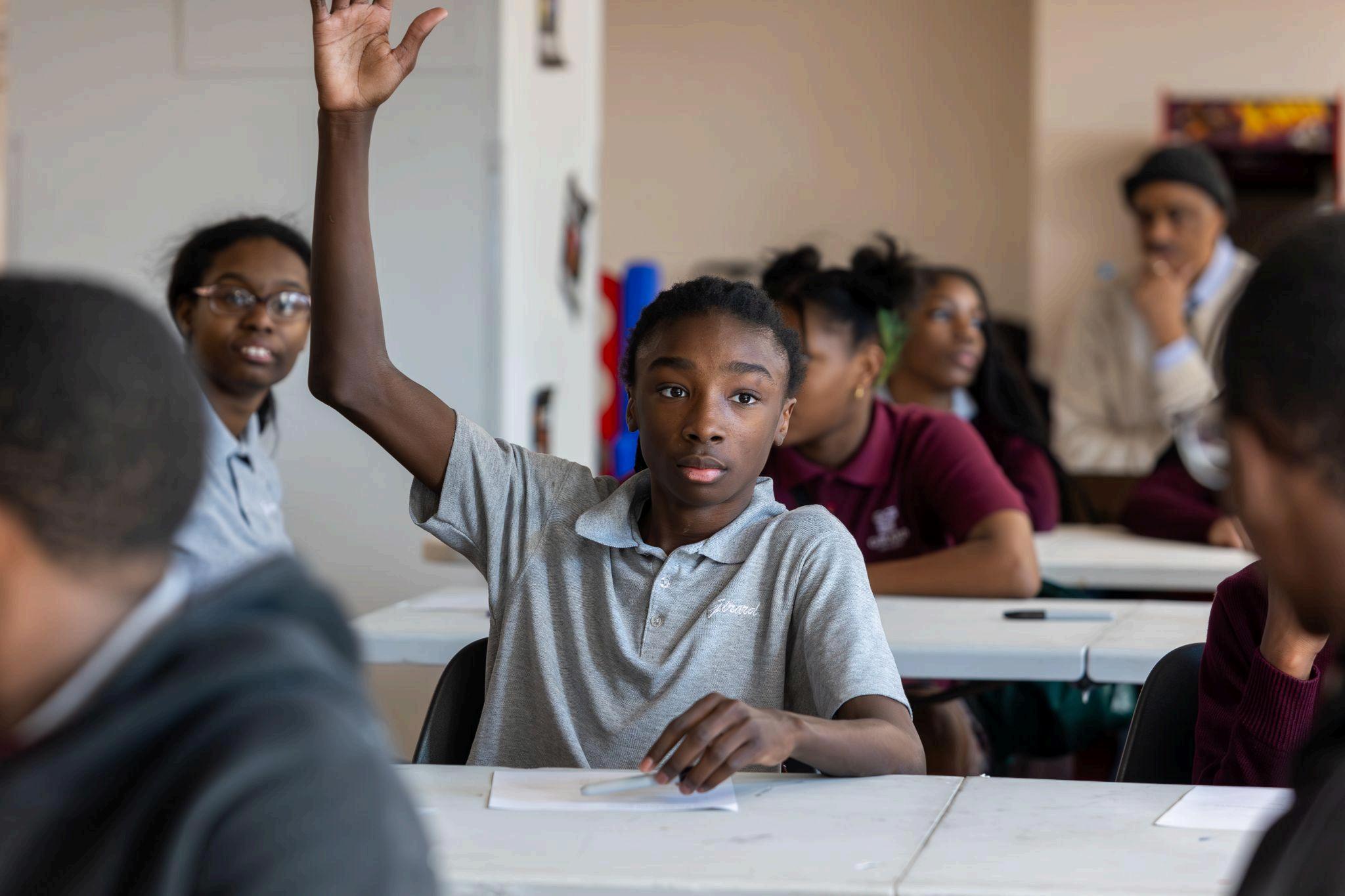
GRADE 7
ELA
Reading to Learn: Analyze and interpret texts, focusing on key details and the author’s craft Use evidence to support conclusions and understand the interactions between events, characters, and ideas. Examine the author’s point of view and how text structure contributes to meaning. Interpret figurative language and compare different formats of the same text.
Writing: Write for various purposes, focusing on detail, organization, and evidence. Conduct research projects, evaluate sources, and respond analytically to texts.
Speaking & Listening: Engage in discussions, listening and building on others' ideas Take responsibility in small-group discussions and use academic language to deepen understanding of texts. Make connections across texts and share insights.
Language: Use correct grammar, clarify word meanings with context clues, and expand vocabulary through academic language
Math | Level 7/8
Numbers & Operations: Distinguish between rational numbers and irrational numbers. Solve real-life problems using fractions, decimals, and percentages.
Algebraic Concepts: Solve problems with equations or graphs. Use square and cube roots. Analyze linear relationships, slopes, and systems of equations. Understand functions and their rates of change through tables and graphs.
Geometry: Solve problems involving area, volume, surface area, angles, and circumference. Apply the Pythagorean Theorem and understand geometric transformations.
Measurement, Data, and Probability: Make inferences from data and solve probability problems. Interpret scatter plots and analyze relationships using frequencies and probability models.
Mathematics Practices: Solve problems using different methods (tables, graphs, equations). Critique reasoning and use tools like calculators or rulers appropriately.
Financial Literacy: Set financial goals and understand opportunity costs. Learn about financial products like checking accounts and loans Explore how education affects income and funding options like scholarships. Understand pay statements, gross vs. net pay, and deductions. Evaluate pricing methods to make smart purchases. Learn personal budgeting, including income, expenses, and savings. Understand charitable giving Set savings goals and calculate growth with simple interest. Discuss managing financial risks like job loss or medical expenses.
Science
Understanding Matter: Learn how matter changes states, and differentiate between substances and mixtures. Understand endothermic and exothermic reactions, and distinguish between synthetic and natural materials
Earth’s Changes: Study the movement of continents, the theory of plate tectonics, and how mountains, volcanoes, minerals, and rocks form Understand the causes of earthquakes, volcanoes, and severe weather.
Earth’s Resources: Learn about the types, locations, and uses of natural resources Study how geologic processes affect resource distribution and how humans access them
Interactions with the Ecosystem: Explore how plants convert sunlight and how plants/animals release energy Understand energy cycling in ecosystems and symbiotic relationships. Explain human impact on ecosystems
Social Studies
Historical Thinking: Analyze primary and secondary sources to evaluate key events and their short- and long-term consequences.
Reading & Writing: Source reliable information, identifying key details (what, when, why, who, how). Analyze documents for claims and evidence.
Map Literacy and Geography: Examine population shifts from migration and the impact of geography on the American Revolution and War of 1812.
American History:
Study early empires, the discovery of the Americas, the transatlantic slave trade, and European colonization Analyze the causes and events of the American Revolution, and explore the contributions of Washington, Adams, and Jackson to the development of the U.S. government.
Career Education & Work
Career Awareness and Exploration: Explore different careers by comparing what education and training are needed and by researching what jobs are available locally and globally
Employability Skills: Develop professional communication skills and learn how to manage time effectively while working with others
Growth and Advancement: Reflect on goals and understand how education and building skills can help in reaching future goals
Personal Interests and Career Planning: Learn how to research careers and begin outlining a plan based on interests, strengths, and goals.
Lifeskills
Self Care: Have a self care routine, maintain general cleanliness and hygiene routines. Understand consent and know where to seek reliable health information. Learn babysitting basics including child and infant CPR Learn road safety and safety in public spaces Learn to make safe choices when out alone or using public transportation.
Daily Living: Can manage a list of age appropriate tasks and household/dorm chores (including cleaning appliances) and recognize tasks that need to be done and take action without being prompted Understand basic kitchen safety (knife skills/safety, cooking temps, kitchen tools) Can cook basic meals and follow simple recipes Learn to be a self-starter, take on responsibilities and learn from mistakes. Learn how to analyze media messages about engaging in vaping, drugs and alcohol Can mend and iron clothes and shine shoes. Can wrap a present and write a thank you note.
Communication: Can communicate clearly and confidently Learn to advocate for themselves respectfully. Send proactive emails to teachers/RAs to get support, ask for clarity or communicate. Learn basic social graces (respect elders and actively listen).
By the end of 7th grade at Girard College a student will be able to say:
“I can apply the Pythagorean Theorem to solve problems about triangles and their sides.”
“I can read a novel and compare it to a historical article on the same topic, using evidence from both texts to support my conclusions ”
“I can create a model to explain the basic structures and functions of cells.”
“I know the causes and effects of the American Revolution.”
“I can ask a local business for a donation by writing a professional email.”
“I can lay out the steps for completing my school projects.”
School & Study Life: Can keep a planner and add events, to-dos and important deadlines. Think about future goals. Can independently complete school work, check work for mistakes and submit work on time Keep everything neat and organized Read for pleasure Learn a media balance strategy, how companies use your data, digital footprints and our future, impact of social media, respond to cyberbullying and what rights to fair use exist as a creator
Social Relationships: Develop empathy perspective-taking and compromise during
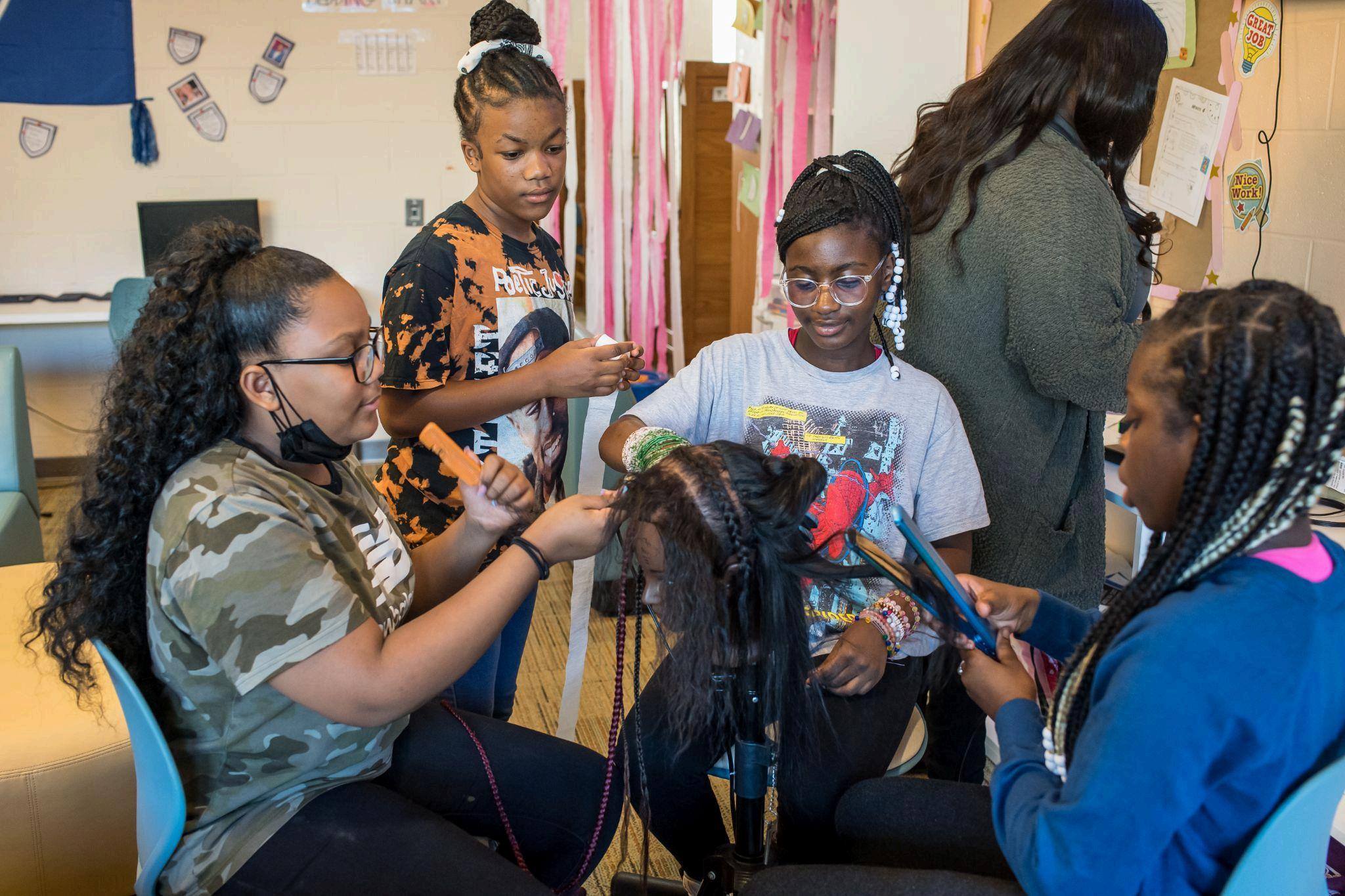
GRADE 8
ELA
Reading to Learn: Analyze and interpret texts, focusing on key details, the author’s point of view, and connections between ideas. Use evidence to support conclusions and understand the impact of text structure and language
Writing: Write for various purposes, including research and reflection. Stay focused, use detail, and organize writing well. Gather information from reliable sources and use evidence to support writing.
Speaking & Listening: Engage in discussions, listen to others, and build on their ideas. Take responsibility in group discussions and connect ideas across multiple texts.
Language: Apply grammar and punctuation rules for clarity. Use language to convey meaning more effectively Use context clues to understand word meanings and expand vocabulary by learning word relationships, word structure and using academic terms.
Math | Algebra I
Numbers and Operations: Understand and use different forms of numbers like fractions, decimals, percentages, square roots, and exponents. Solve problems using these numbers and their relationships
Linear Equations and Inequalities: Write and solve linear equations and inequalities using various methods, including graphing.
Functions and Coordinate Geometry: Analyze and interpret functions through equations, graphs, or tables. Calculate and use the slope of a line and interpret data from scatter plots
Data Analysis: Use data displays to solve problems, make predictions, and understand measures like mean and range.
Mathematical Practices: Justify math solutions, explain them to others, and apply math to real-life problems Use appropriate tools effectively and strategically.
Financial Literacy: Refine long-term financial planning. Learn about financial services like investing and retirement accounts. Understand saving vs investing, stock prices, and dividends Assess the role of values and risk tolerance in financial decisions. Explore types of credit and their costs Learn borrower and lender rights Compare insurance types and their role in managing financial risk. Understand how to protect against fraud and identity theft
Science
Change Over Time: Use rock layers and fossils to understand Earth's history. Explain DNA organization and the theory of evolution, including natural, sexual, and artificial selection. Discuss human population growth and its impact on consumption.
Exploring the Universe: Study
Earth’s motion and seasons, explain moon phases and eclipses, and understand Earth's place in the solar system. Investigate the concept of gravity
Energy & Motion: Calculate speed and acceleration, understand forces, and distinguish between kinetic and potential energy. Learn energy conservation and how to interpret magnetic and electric forces in simple circuits.
Understanding Waves:
Identify wave types and properties. Describe wave interactions and understand how light travels, reflects, refracts, and produces color.
Social Studies
Historical Thinking: Analyze how historians construct arguments, interpret evidence, and recognize patterns in history Understand the significance of historical shifts and different perspectives.
Reading & Writing:
Corroborate multiple sources to support claims and write an essay using at least four sources.
Map Literacy and Geography: Use historical data to identify patterns and analyze how population density affects resources, particularly with the development of industries and the transcontinental railroad.
American History: Study Manifest Destiny, the causes and impact of the Civil War, Reconstruction, Jim Crow segregation, and the transcontinental railroad’s impact on cultures. Explore the Gilded Age, imperialism, World War I, and the cultural significance of the Harlem Renaissance.
Career Education & Work
Career Awareness and Exploration: Research and analyze different careers, understand the job market, and learn about laws that protect workers
Employability Skills: Apply critical thinking and professional communication while using technology to solve problems and manage projects.
Growth and Advancement: Evaluate how learning, skill-building, and work habits impact future opportunities and life choices.
Personal Interests and Career Planning: Develop a personal career plan by connecting interests and strengths to potential careers and action steps
Lifeskills
Self Care: Have a self care routine, maintain general cleanliness and hygiene routines (including haircuts/haircare, skin care and dental care). Learn about sexual health, pregnancy prevention and STDs Can make safe choices when out alone or using public transportation Knows how to access mental health support when needed.
Daily Living: Maintain a clean living space including laundry Understand kitchen safety (fire extinguisher and first aid). Can cook balanced meals using multiple kitchen appliances. Establishing routines to tackle responsibilities and commitments Can create and follow a budget Know the harmful consequences of vaping, drugs and alcohol, current use trends and how to say “no.” Can wash and clean a car.
Communication: Can communicate clearly and confidently needs and wants. Learn to express feelings, handle conflict calmly and set boundaries. Learn to advocate for themselves respectfully and seek advice from trusted adults Understand basic social graces and how to behave in different situations.
By the end of 8th grade at Girard College a student will be able to say
“I understand how to calculate the slope of a line and use it in problems.”
“After reading a novel, I can participate in class discussions on its themes using academic language, such as "symbolism" and "character development."
“I can compare how different simple machines make tasks easier, and argue which machine is the best for a job.”
“I can share cultural aspects of the Harlem Renaissance.”
“I know that working hard and learning new things now can help me get a job or internship in high school.”
“I’m responsible for keeping my dorm area clean and organized ”
School & Study Life: Learn to organize and prioritize schoolwork, extra curricular activities and social events. Think about future goals and have a plan for achieving goals. Complete school work and have a study routine to maintain achieving grades and academic progress. Keep everything neat and organized Read for pleasure Can leverage school resources to get things done. Learn how digital media impacts your brain, protect your privacy, social media’s impact on your digital footprints, risks and consequences of sexting, respond to online hate speech and react to breaking news
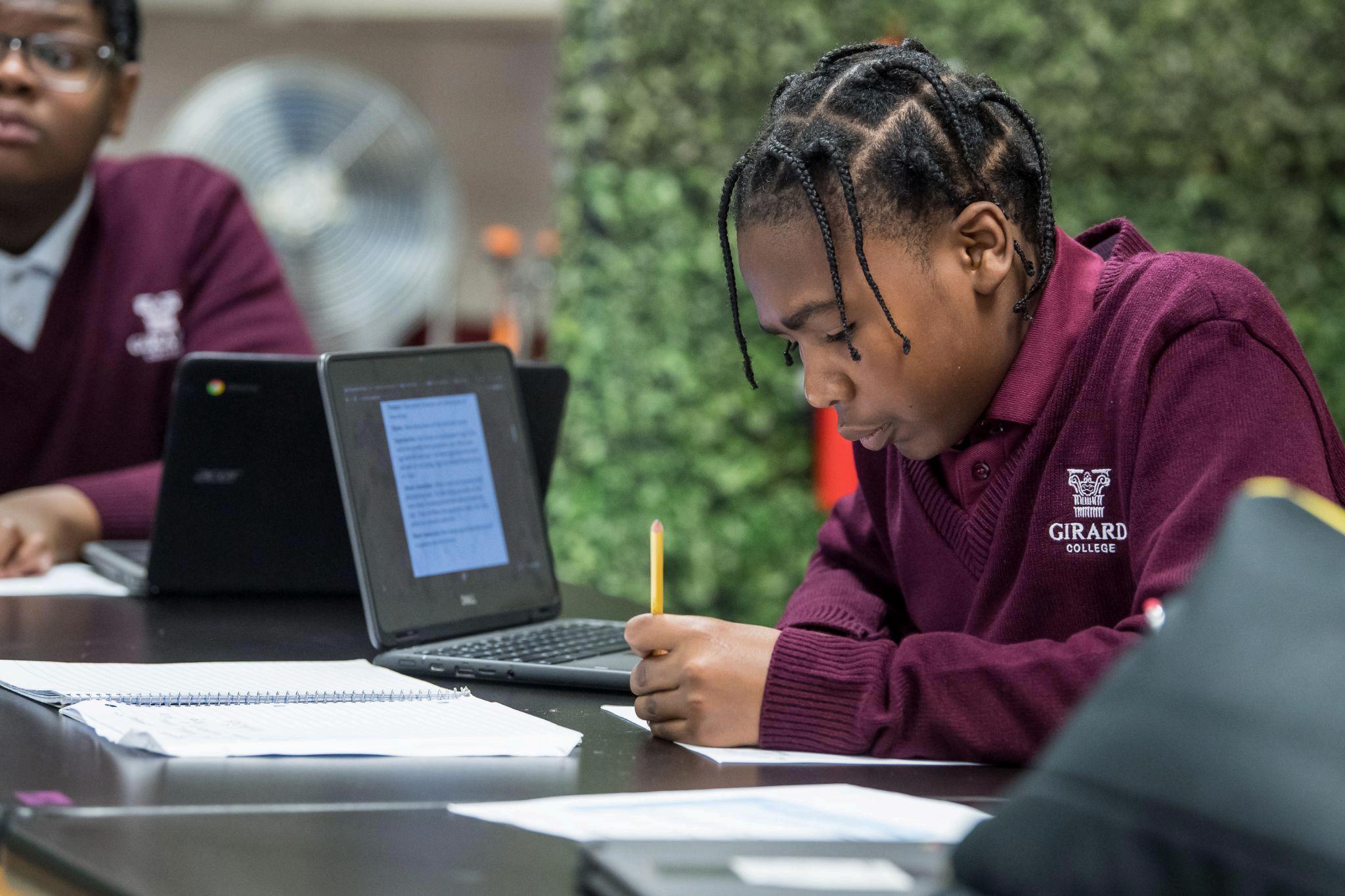
HIGH SCHOOL
At Girard College High School, our classrooms promote our core values by developing independent thought, encouraging students to voice individual opinions, and trust that students will listen to and value one another’s opinions with compassion. Cooperative discussions, one-on-one conferences with faculty, and individual work encourage students to think and perform independently and to solve problems in innovative ways. ADD SIGNATURE
PROGRAMS HERE
Every classroom aims to cultivate the following:
Empathic Stewardship
Our coursework empowers students to see their community through a global lens and to craft thoughts that come from evidence based analysis. Information literacy skills — the ability to locate, evaluate, and use information critically are taught in the context of effecting change in our communities through rigorous instruction, project based learning, and community partnerships We want students to develop deep empathy so our curriculum emphasizes student voice so students can make meaning of their learning in authentic ways.
Dynamic Community Partnerships
The academic curriculum expands beyond the walls of the high school building and campus, and into the community. Students have opportunities to take Dual Enrollment classes at several institutions of higher education across the city Seniors engage in a 3 month senior project that allows them to spend time off campus engaged in work environments, including internships and volunteering at non-profit organizations.
Critical Thinking
We challenge our students to be critical thinkers and independent learners who are inquisitive, confident and resilient
Future Ready
Students are engaged in grade level seminars to build life skills and intentionally prepare our students for future careers and learning experiences, and build strong social competencies to ensure they can succeed in their future
Wellness
In addition to the core academic curriculum, every student must take courses in health and fitness to promote wellness and the mind-body integration essential to adolescent development.
Intentional Exposure
Courses in the arts are required, as we believe that creativity is an important complement to analytic thinking and value its role in all aspects of life. Varied electives enhance our Course Offerings to prepare students to be cutting-edge 21st century leaders. 22 | The Student Experience Arc of Learning Guide
Graduation Requirements
Our high school graduation requirements are designed to ensure that every student is well-prepared for post-secondary education and future career opportunities. To graduate, students must complete a rigorous and balanced curriculum that includes core academic subjects, electives, and extracurricular activities. Our requirements emphasize the development of critical thinking, problem-solving, and communication skills, alongside fostering personal growth and civic re
Students are required to earn 25 credits to graduate. Classes that run per week year-round will earn 0.5 credits and a class for a single perio are built into the core curriculum, but students can take electives and graduation requirements include at minimum:
● English: 4 credits
● Math: 4 credits
● Science: 4 credits
● History: 3 credits
● World Languages (French or Spanish): 3 credits (4 credits if participating in World Language Trip Abroad)
● Physical Education & Health: 1 credit
● Fine Arts: 1 credit
● Performing Arts: 1 credit
● Financial Literacy: 0.5 credit
● Senior Project: completion of capstone project/internship
● Athletics: 3 years of participation in at least one season of competitive sport in grades 9-11
At the discretion of Girard College’s High School Principal, students may transfe completion of Algebra I and may transfer up to 1 credit hour from their Middle S 23 | The Student Experience Arc of Learning Guide
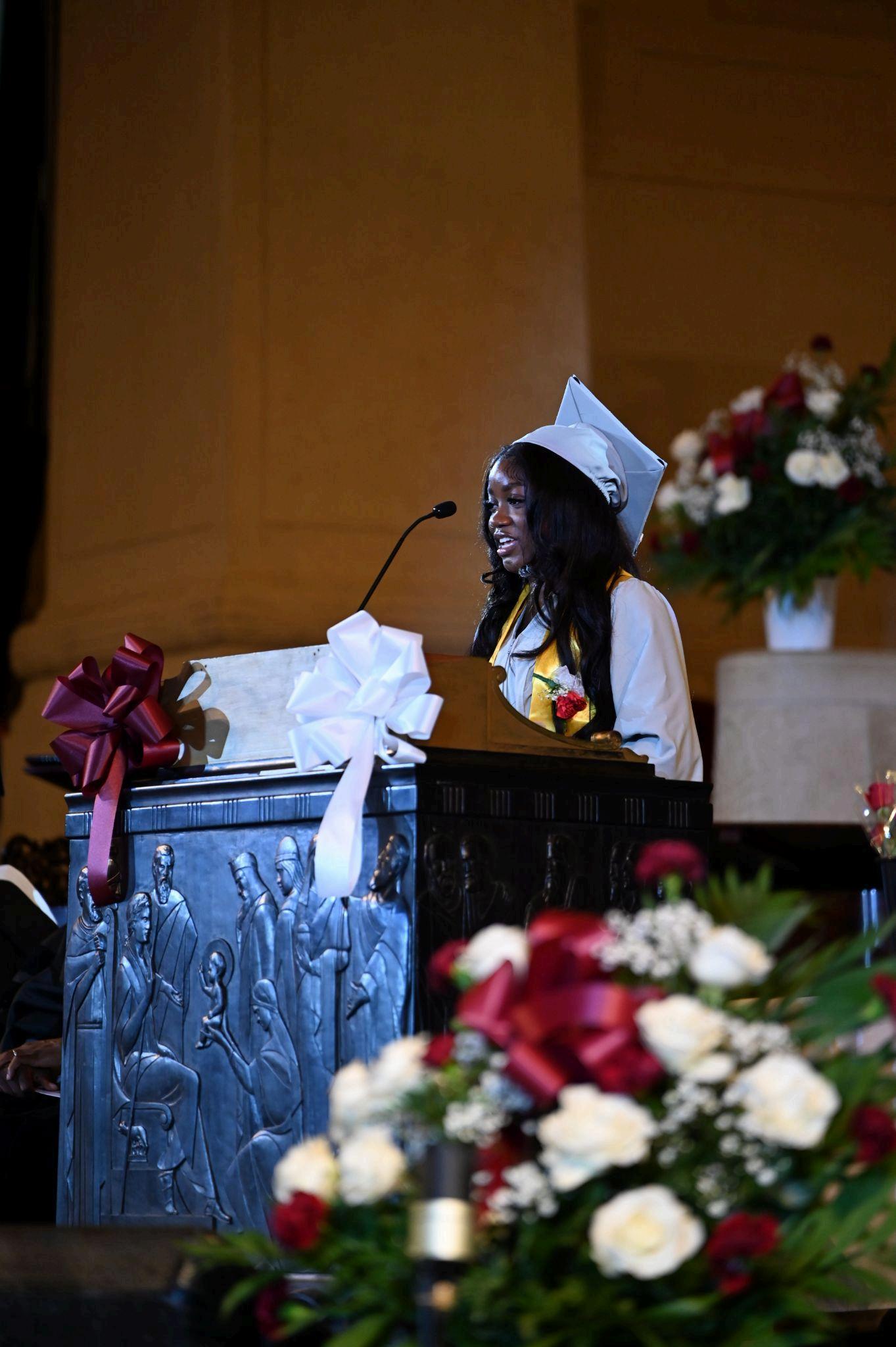
Graduation Requirement - 4 Credits Total: Algebra I* → Geometry → Algebra II → Precalculus
Algebra I Geometry
Seeing Structure in Expressions: Interpret the structure of expressions Write expressions in equivalent forms to solve problems.
Arithmetic with Polynomials and Rational Expressions: Perform arithmetic operations on polynomials. Understand the relationship between zeros and factors of polynomials. Use polynomial identities to solve problems. Rewrite rational expressions
Creating Equations: Create equations that describe numbers or relationships.
Reasoning with Equations and Inequalities: Understand solving equations as a process of reasoning and explain the reasoning Solve equations and inequalities in one variable. Solve systems of equations. Represent and solve equations and inequalities graphically.
Congruence: Experiment with transformations in the plane. Understand congruence in terms of rigid motions Prove geometric theorems Make geometric constructions.
Similarity, Right Triangles, and Trigonometry: Understand similarity in terms of similarity transformations. Prove theorems involving similarity. Define trigonometric ratios and solve problems involving right triangles Apply trigonometry to general triangles.
Circles: Understand and apply theorems about circles Find arc lengths and areas of sectors of circles.
Expressing Geometric Properties with Equations: Translate between the geometric description and the equation for a conic section. Use coordinates to prove simple geometric theorems algebraically.
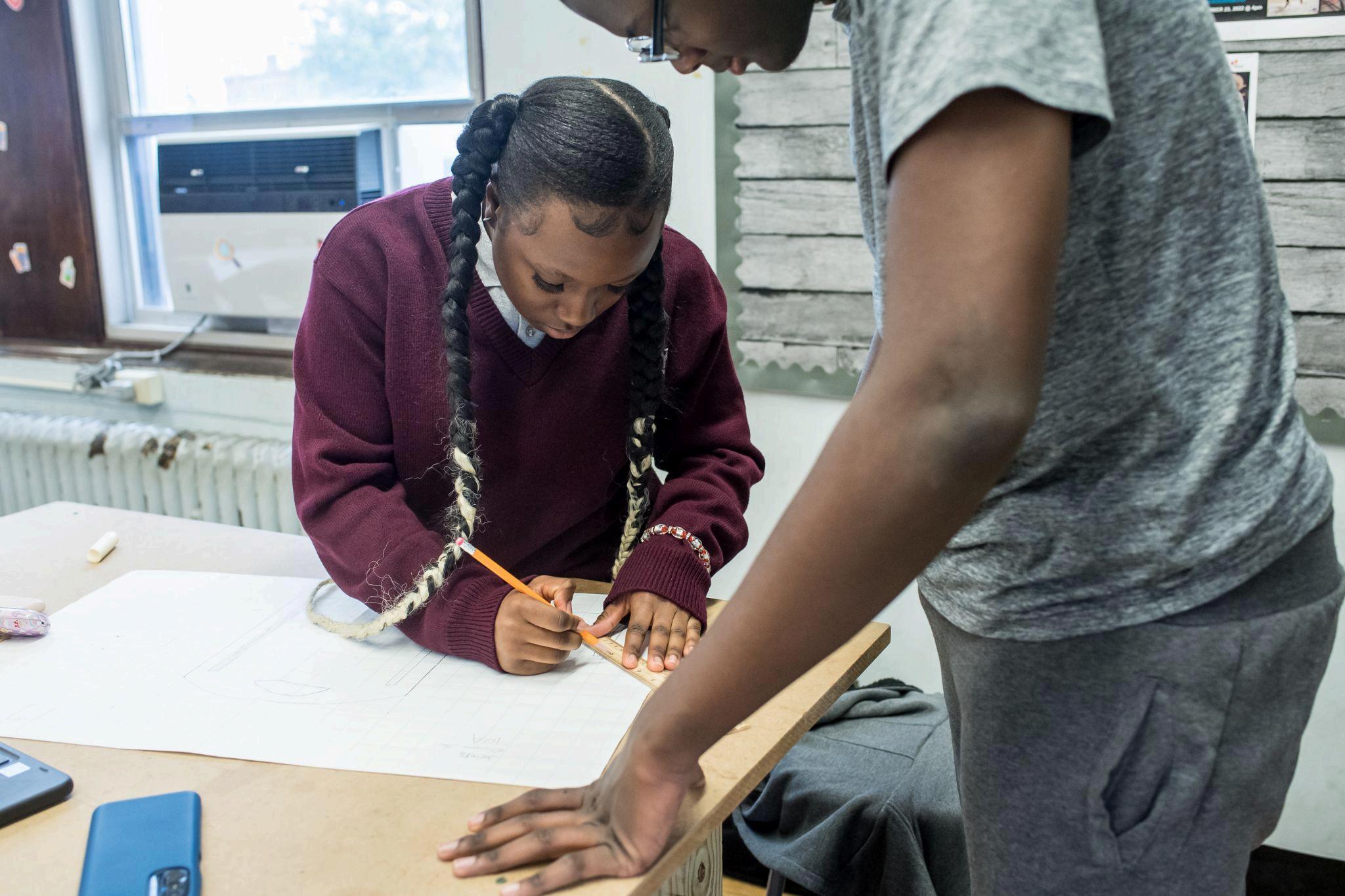
eometric Measurement and Dimension: Explain volume formulas and use em to solve problems. Visualize relationships between two dimensional and ree-dimensional objects
odeling with Geometry: Apply geometric concepts in modeling situations
Algebra II Pre-Calculus
Numbers and Operations: Extend the properties of exponents to rational exponents. Reason quantitatively and use units to solve problems. Perform arithmetic operations with complex numbers Use complex numbers in polynomial identities and equations.
Algebra: Interpret the structure of expressions Write expressions in equivalent forms to solve problems. Understand the relationship between zeros and factors of polynomials. Use polynomial identities to solve problems. Rewrite rational expressions Create equations that describe numbers or relationships
Reasoning with Equations and Inequalities: Understand solving equations as a process of reasoning and explain the reasoning Solve equations and inequalities in one variable. Solve systems of equations. Represent and solve equations and inequalities graphically
Interpreting and Building Functions: Understand the concept of a function and use function notation Interpret functions that arise in applications in terms of the context. Analyze functions using different representations. Build a function that models a relationship between two quantities. Build new functions from existing functions
Linear, Quadratic, and Exponential Models: Construct and compare linear, quadratic, and exponential models and solve problems Interpret expressions for functions in terms of the situation they model.
Trigonometric Functions: Extend the domain of trigonometric functions using the unit circle. Model periodic phenomena with trigonometric functions. Prove and apply trigonometric identities.
Number and Quantity: Perform arithmetic operations with complex numbers Represent complex numbers and their operations on the complex plane. Represent and model with vector quantities. Perform operations on vectors. Perform operations on matrices and use matrices in applications
Algebra: Interpret the structure of complex expressions. Rewrite rational expressions Create equations that describe numbers or relationships Solve systems of linear, nonlinear, and trigonometric equations, including those involving three variables
Functions: Interpret and analyze a variety of advanced function types including polynomial, rational, exponential, logarithmic, and trigonometric functions. Analyze piecewise, trigonometric, and parametric functions using different representations. Build new functions from existing functions. Extend the domain of trigonometric functions using the unit circle Model periodic phenomena with trigonometric functions. Prove and apply trigonometric identities.
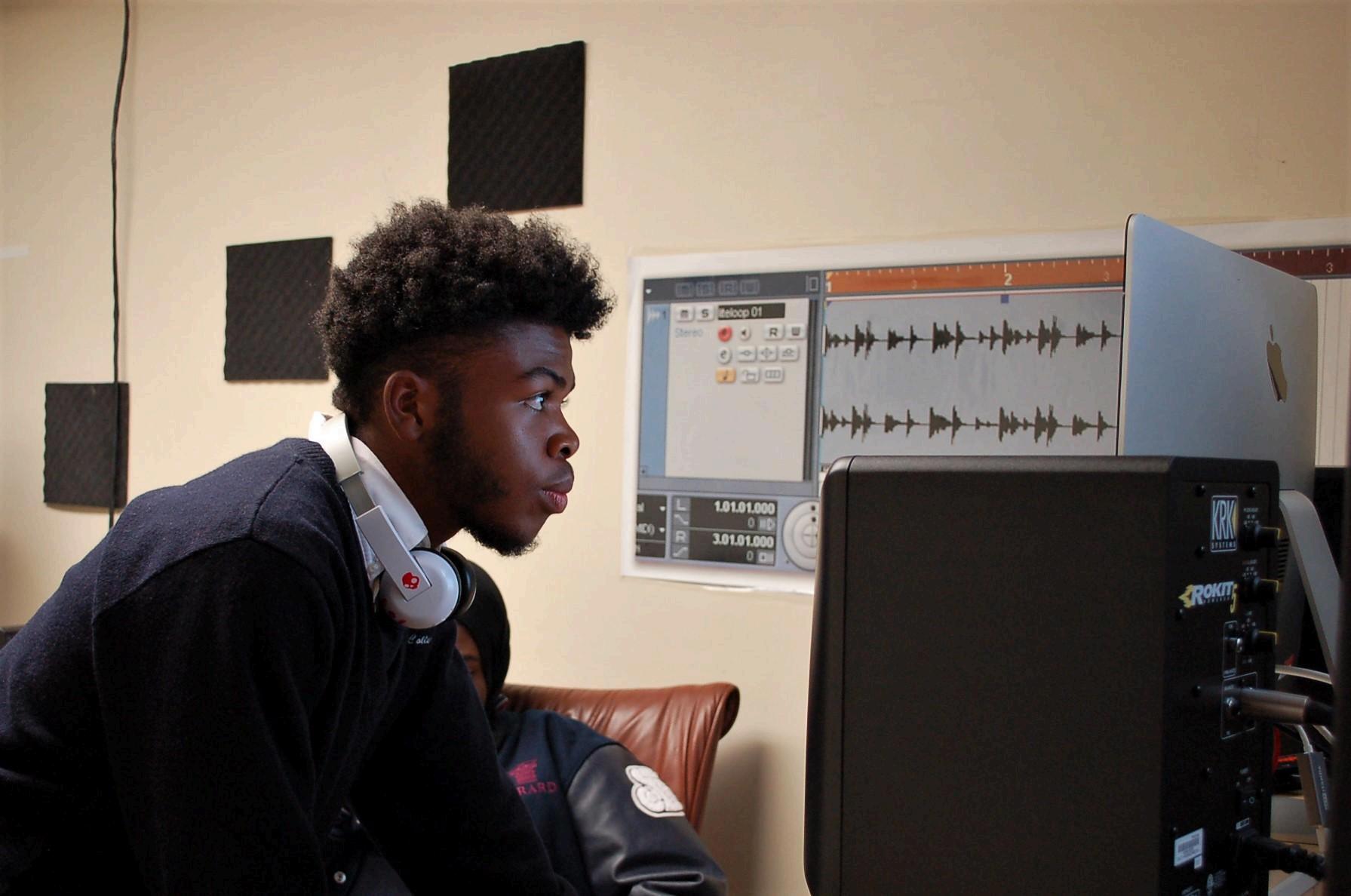
Differentiated Courses (optional electives): AP Calculus AB | Statistics & Probability
AP Calculus AB Statistics & Probability
Grade 11-12 | 1.0 credits | Elective | Prerequisite(s): Pre-Calculus and Teacher Recommendation
Grade 11-12 | 1.0
credits | Elective | Prerequisite(s): Pre-Calculus
Limits and Continuity: Understand the concept of limits. Explore properties and representations of limits Examine continuity of functions Investigate asymptotes and limits at infinity Reason using the Squeeze Theorem and Intermediate Value Theorem.
Differentiation: Definition and Fundamental Properties: Define the derivative of a function Connect differentiability and continuity. Determine derivatives for elementary functions. Apply differentiation rules.
Differentiation: Composite, Implicit, and Inverse Functions: Apply the chain rule. Understand and use implicit differentiation. Differentiate inverse functions. Determine higher-order derivatives of functions
Contextual Applications of Differentiation: Identify mathematical information in real-world problems Apply differentiation to motion problems Generalize motion problems to other situations involving rates of change. Solve related rates problems. Understand local linearity and approximation. Apply L’Hospital’s Rule
Analytical Applications of Differentiation: Apply the mean and extreme value theorem. Analyze derivatives and properties of functions Use the first and second derivative tests Use the candidates test. Sketch graphs of functions and their derivatives. Solve optimization problems and analyze implicit relations.
Integration and Accumulation of Change: Understand the concept of definite integrals. Approximate integrals using Riemann Sums. Understand accumulation functions. Apply the Fundamental Theorem of calculus Explore antiderivatives and indefinite integrals Understand and apply properties of integrals and integration techniques.
Differential Equations: Interpret verbal descriptions of change as separable differential equations Sketch slope fields and families of solution curves. Solve separable differential equations to find general and particular solutions. Derive and apply a model for exponential growth and decay.
Applications of Integration: Determine the average value of a function using definite integrals. Model particle motion Solve accumulation problems Find the area between curves Determining volume with cross-sections, the disc method, and the washer method.
Interpreting Categorical and Quantitative Data:
Summarize, represent, and interpret data on a single count or measurement variable Summarize, represent, and interpret data on two categorical and quantitative variables. Interpret linear models.
Making Inferences and Justifying Conclusions:
Understand and evaluate random processes underlying statistical experiments Make inferences and justify conclusions from sample surveys, experiments and observational studies
Conditional Probability and the Rules of Probability: Understand independence and conditional probability and use them to interpret data. Use the rules of probability to compute probabilities of compound events in a uniform probability model
Using Probability to Make Decisions: Calculate expected values and use them to solve problems Use probability to evaluate outcomes of decisions
Personal Finance
Grades 11-12 | 0.5 credits | Required | Prereq
Personal Finance Fundamentals: Set long-te make decisions considering opportunity cost affect financial choices and the benefits of sh Compare financial service providers and unde management and financial technology Organ and understand legal aspects like wills and be about financial regulators and consumer prot
Income: Identify types of income (earned, un sources, including retirement options. Unders and their impact on future earnings Research evaluate the effects of labor markets and ben Assess the financial impact of self-employme contracting Calculate taxes and complete ta
Spending: Develop a strategy for making info saving money. Create and evaluate a persona variable expenses. Compare payment method their effect on spending Analyze housing an including loans and ownership costs. Underst impact of sales and property taxes. Justify ch
Saving & Investing: Calculate net worth by e liabilities. Create short and long-term savings plans, compare savings vehicles, and interest rates Understand factors affecting investment returns, types of investments, and how to select advice sources. Build a diversified portfolio for specific goals.
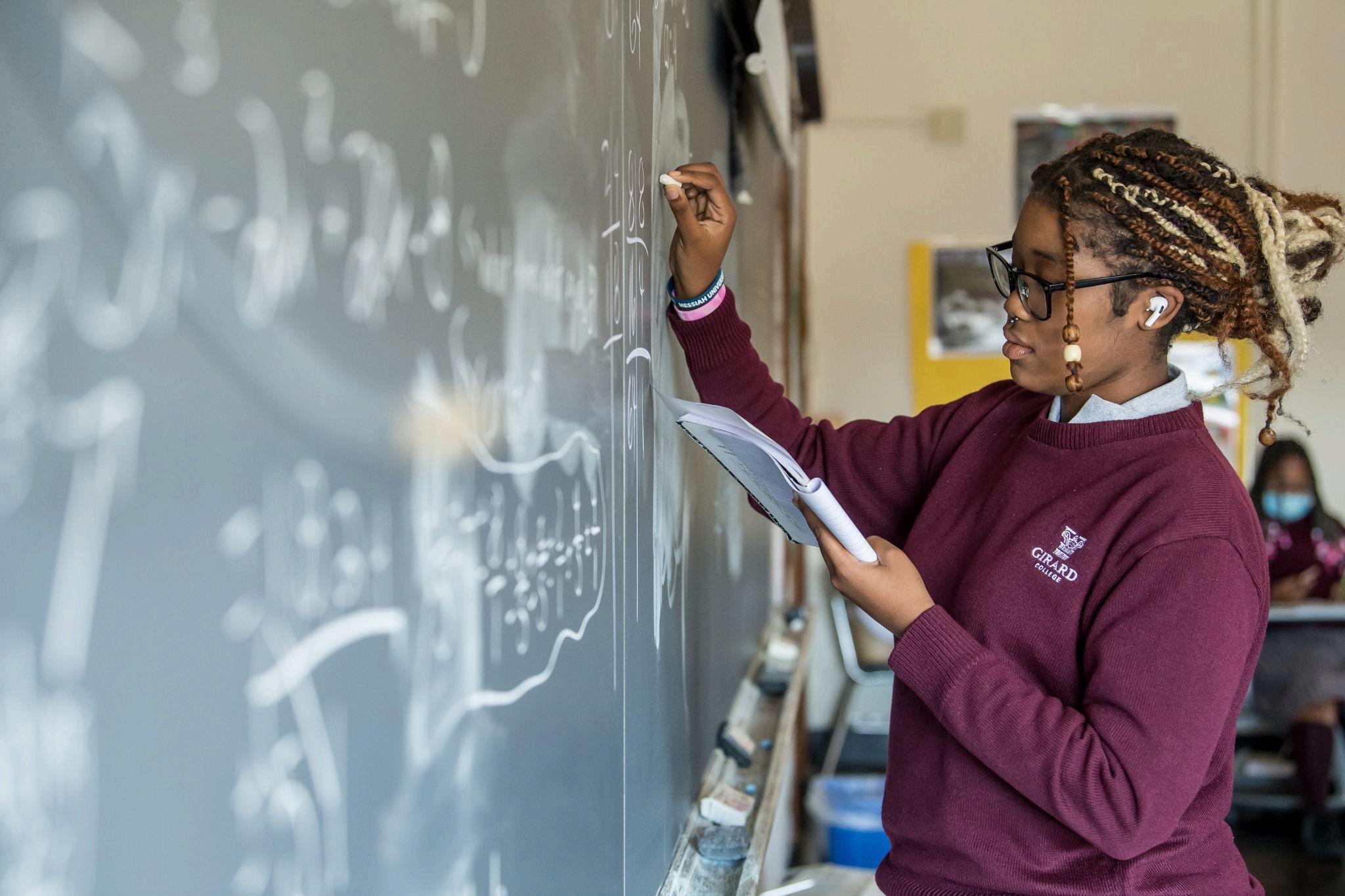
By the end of high school at Girard College a student will be able to say:
Risk & Insurance: Assess financial risks and explore ways to manage them. Recommend appropriate insurance (e.g., auto, health, life) based on needs, and compare providers and plans Learn how to evaluate insurance options, understand costs, and file claims. Understand when insurance proof or minimum coverage is needed Learn about public insurance programs and fraud risks, and know how to report fraud or identity theft.
“I can solve systems of equations.”
“I can prove geometric theorems.”
“I can compare linear, quadratic, and exponential models.”
“I can apply trigonometry to general triangles.”
ENGLISH LANGUAGE ARTS
Graduation Requirement -4 Credits Total: English I → English II → English III → English IV or AP Eng. Lang & Comp
Differentiated Course (optional elective): English IV
English I & English II
Reading: Interacting with text through close reading, analysis, and interpretation. Engaging and interacting with the text (deep reading of text) to discern not only the craft of the writer, but the connectivity to other texts and citing evidence to support a conclusion. Reading and analyzing seminal U.S. documents of historical and literary significance, including how they address related themes and concepts
Writing: Writing routinely over extended periods (research, reflection, and revision) and shorter periods (a single sitting) for a range of tasks, purposes, and audiences. Establishing and sustaining a precise controlling idea/claim/counterclaim/position, choosing sophisticated organizational strategies, including a clear and well-defined introduction, body, and conclusion with relevant evidence. Choosing an effective style, tone, and point of view. Building knowledge on a subject through research projects and responding analytically to literary and informational sources
Speaking & Listening: Listening attentively and critically, responding thoughtfully, and building upon the ideas of others Talking about texts in order to develop knowledge of academic language and conceptual understanding. Discussing and making connections among multiple texts using intra-, inter-, and extratextual questions.
Language: Demonstrating a command of standard English: grammar, usage, mechanics, precise language, and varied sentence structures. Determining or clarifying the meaning of unknown and multiple meaning words through context clues, understanding word relationships and nuances in meanings, and understanding the structure of words. Acquiring and using general academic and domain-specific words and phrases; gathering vocabulary knowledge.
Reading: Interacting with text through close reading, analysis, and interpretation. Engaging and interacting with the text (deep reading of text) to discern not only the craft of the writer, but the connectivity to other texts and citing evidence to support a conclusion Reading and analyzing seminal U.S. documents of historical and literary significance, including how they address related themes and concepts.
Writing: Writing routinely over extended periods (research, reflection, and revision) and shorter periods (a single sitting) for a range of tasks, purposes, and audiences Establishing and sustaining a precise controlling idea/claim/counterclaim/position, choosing sophisticated organizational strategies, including a clear and well-defined introduction, body, and conclusion with relevant evidence Choosing an effective style, tone, and point of view. Building knowledge on a subject through research projects and responding analytically to literary and informational sources
Speaking & Listening: Listening attentively and critically, responding thoughtfully, and building upon the ideas of others Talking about texts in order to develop knowledge of academic language and conceptual understanding. Discussing and making connections among multiple texts using intra-, inter-, and extratextual questions
Language: Demonstrating a command of standard English: grammar, usage, mechanics, precise language, and varied sentence structures Acquiring and using general academic and domain-specific words and phrases, sufficient for reading, writing, speaking, and listening at the college and career readiness level; demonstrating independence in gathering vocabulary knowledge
Differentiated Course (optional elective): AP English Language and Composition
AP English Language and Composition
Grade 12 | 1.0 credits | Recommended | Prerequisite(s): English III and Teacher Recommendation
Claims and Evidence: Identify the purpose and intended audience of a text Examine how evidence supports a claim. Develop paragraphs as part of an effective argument.
Designing Purpose: Analyze the audience and its relationship to the purpose of an argument Build an argument with relevant and strategic evidence. Develop thesis statements. Develop structure and integrate evidence to reflect a line of reasoning.
Perspectives and Arguments: Identify and describe different claims or lines of reasoning. Identify and avoid flawed lines of reasoning. Introduce and integrate sources and evidence. Use sufficient evidence for an argument Attribute and cite references Develop parts of a text with cause-effect and narrative methods.
Method Development: Develop and connect thesis statements and lines of reasoning Develop introductions and conclusions. Develop parts of a text with comparison–contrast and definition–description methods
Developing Coherence: Develop commentary throughout paragraphs. Maintain ideas throughout an argument Use modifiers to qualify an argument and convey perspective Use transitions
Position vs. Perspective: Incorporate multiple perspectives strategically into an argument. Recognize and account for bias Adjust an argument to address new evidence Analyze tone and shifts in tone
Complexity: Examine complexities in issues. Consider how words, phrases, and clauses can modify and limit an argument Examine how counterarguments or alternative perspectives affect an argument. Explore how sentence development affects an argument
Stylistic Choices: Choose comparisons based on an audience Consider how sentence development and word choice affect how the writer is perceived by an audience. Consider how all choices made in an argument affect the audience Consider how style affects an argument
Complex Arguments: Strategically concede, rebut, or refute information Craft an argument through stylistic choices like word choice and description

By the end of high school at Girard College a student will be able to say:
“I can understand challenging texts through close reading, analysis, and interpretation.”
“I can tailor my writing to be for a specific task, purpose and audience.”
“I can engage in discussions about a text to further develop my conceptual understanding.”
“My writing demonstrates my command of standard English and grammar.”
Graduation Requirement -4 Credits Total: Environmental Science → Biology
Environmental Science Biology
Cosmology and Star Life Cycles: Use models to show the Sun's place in the Milky Way Galaxy and the spread of galaxy clusters. Explain the universe’s origin (Big Bang Theory) using data about its expansion, size, and age. Compare the life cycles of stars of different sizes, including our Sun Model how gravity and thermal expansion balance to affect a star's density. Use data to explain a star's brightness based on distance and mass. Explain how heavier elements are created in stars during their life cycles
Earth's Structure and Plate Tectonics: Model how Earth’s internal processes and surface activities shape continents and ocean floors Use data to predict future plate movements by studying current plate motions. Explain how Earth's interior processes, like thermal convection, drive the movement of matter inside Earth. Use plate tectonics to explain trends in the ages of continental and oceanic crust. Combine seismic wave data and Earth’s magnetic field to map its internal structure
Biogeochemical Cycles and Energy Flow: Model the cycling of matter among Earth's atmosphere, hydrosphere, geosphere, and biosphere Model how energy from the Sun flows through Earth's atmosphere, oceans, and land, and how this affects Earth’s temperature.
Geological and Environmental Processes: Evaluate the impact of renewable and nonrenewable resource availability on the development of civilizations.
Cell Structure and Function: Use models to show how DNA codes for proteins, which determine the structure and function of cells Compare and contrast the structure and function of simple prokaryote cells (like bacteria) and more complex eukaryote cells (like plant and animal cells). Use models to explain how substances move in and out of cells through active (requires energy) and passive (no energy needed) transport.
Cell Division and Growth: Show how mitosis creates two identical cells, helping with growth and repair in multicellular organisms. Explain how meiosis passes genetic information from parents to offspring and creates genetic diversity in organisms. Describe how cells specialize and form different tissues and organs to meet the organism’s needs. This happens through specific gene activation or environmental factors
Energy and Metabolism: Model how plants use sunlight to make energy and store it in sugar molecules Explain how cells break down food and oxygen to release energy needed for growth and activity.
Genetics and Inheritance: Use models to show how genetic variations happen, including random combinations of genes, errors in DNA copying, crossover during meiosis, and environmental influences. Explain how natural selection works through four key factors, helping organisms better adapt to their environment.
Ecosystem Sustainability: Develop ideas to help protect and sustain local ecosystems, ensuring they remain balanced and healthy for future generations
Chemistry Physics
Grade 11 | 1.0 credits | Required | Prerequisite(s): Biology
Grade 12 | 1.0 credits | Recomme
Prerequisite(s): Chemistry & Alg
Atomic and Molecular Structure: Model stable matter as having minimal electrical field energy Atoms arrange to minimize energy, ensuring stability. Model electron arrangement in quantized energy levels around an atom’s nucleus, with electrons in specific energy states Use the periodic table to predict element behavior based on properties like reactivity or bonding.
Chemical Bonding and Reactions: Show energy required to break bonds and release when bonds form. Demonstrate mass conservation in reactions, where the mass of reactants equals the mass of products, as atoms rearrange but don’t disappear Model acid-base neutralization and pH scale use, where each step represents a tenfold difference in acidity or basicity. Analyze how concentration, temperature, and surface area affect reaction speed
Solutions and Solubility: Explain how factors like temperature and solute type affect solubility, with ionic compounds dissolving better in water than covalent compounds. Apply the law that compounds have constant element ratios by mass, like H2O always having two hydrogens for one oxygen. Use relationships between pressure, volume, temperature, and particle number (moles) to predict gas behavior, e g , increased temperature increases volume. Catalysts speed reactions by lowering energy requirements.
Nuclear Chemistry and Chemical Equilibrium: Model reversible reactions where the forward and reverse reaction rates are equal, predicting how changes in conditions affect reactant and product amounts. Explain nuclear fission (splitting) and fusion (combining) processes, where atoms release or absorb energy by changing their nuclei.
Force, Motion, and Energy: Inve relationship between force, mas through Newton’s 2nd Law. Use how force affects motion depen mass of the object Develop a m how energy moves or changes f objects interact in a system. Inv demonstrate that energy is con system, meaning energy is neith destroyed but transformed or tr
Electricity and Electrostatics: U describe and predict how objec charges interact with each othe electrostatic forces using Coulumbs Law.
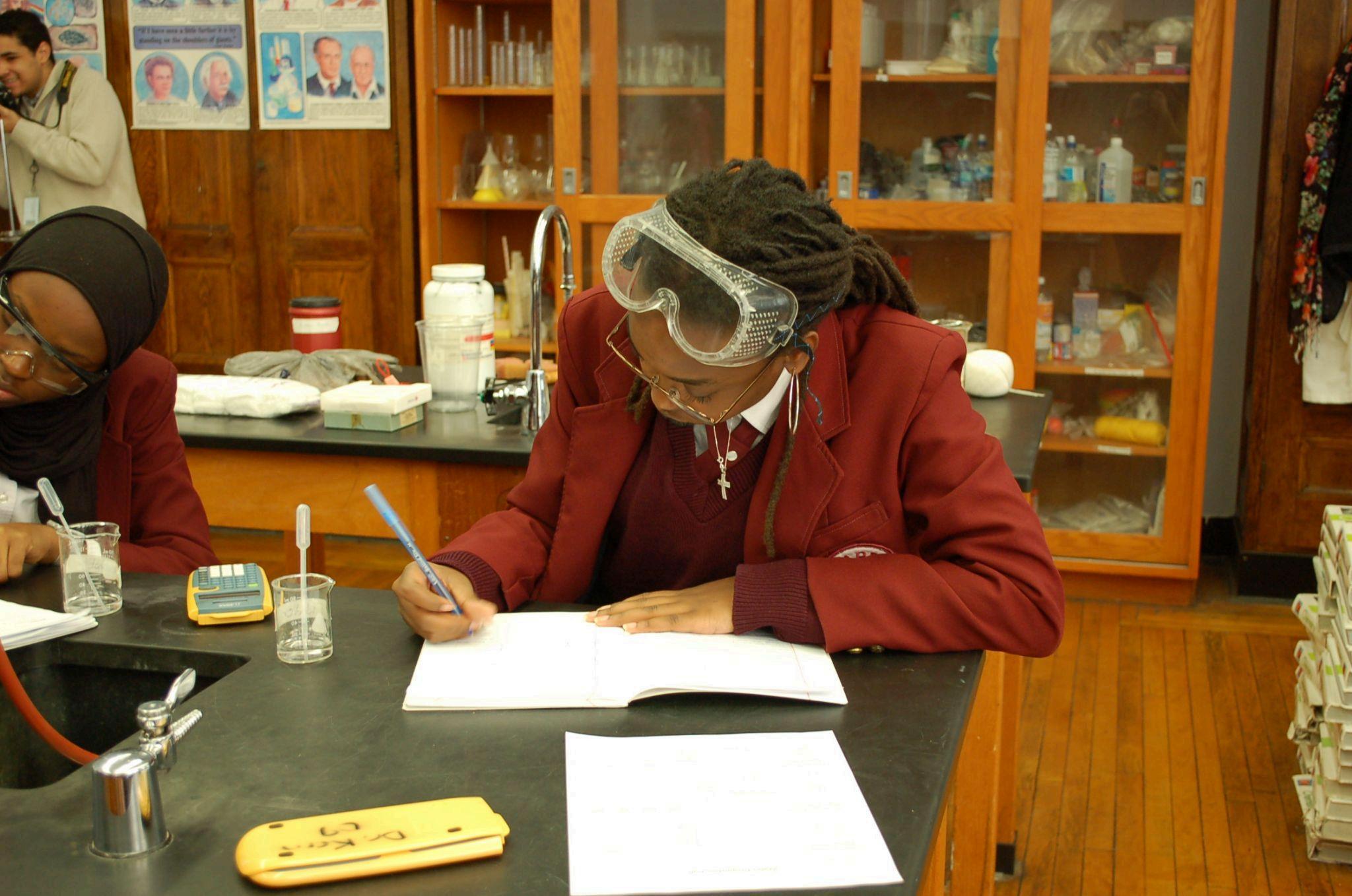
Momentum and Collisions: Use math to show that the total momentum of objects in a system remains constant when no net external force acts on them. Momentum is transferred between objects. Apply scientific and engineering ideas to design devices (e g , airbags) that reduce the force on an object during a collision.
Waves and Resonance: Explain how waves are transmitted, reflected, refracted, or absorbed when they pass through different materials Describe how resonance works in everyday situations, like how musical instruments or stretched strings vibrate at certain frequencies. Analyze data to show that the energy of electromagnetic waves (like light) increases as their frequency increases.
By the end of high school at Girard College a student will be able to say:
“I can explain the earth’s origin as aligned to the Big Bang Theory.”
“I understand that DNA acts as a blueprint that dictates a cell’s structure and function.”
“I understand the organization of the periodic table ”
“I can apply my algebra knowledge to show how force affects motion.
Graduation Requirement -3 Credits Total: World History → US History → AP African American History
World History
Grade 9 | 1.0
Early Civilizations & Global Societies (Prehistory - A.D. 550): Explore the origins of civilization, including early migrations, toolmaking, agriculture, and settlements. Learn about the rise of civilizations in the Middle East, Egypt, India, and China and their lasting impact on culture, politics, and technology
Ancient Americas & Complex Societies (Prehistory - A.D. 1570): Study early American civilizations like the Olmec, Maya, Aztec, Inca, and Mississippians, focusing on their contributions to agriculture, architecture, and social organization.
Classical Civilizations of the Mediterranean and Beyond (1750 B.C. - A.D. 476):
Examine Greek city-states, democracy, and philosophy, and explore the rise of Rome, its expansion, and the rise of Christianity during Augustus’s reign
The Middle Ages & the Rise of Global Civilizations (330 - 1650): Study medieval Europe, feudalism, the church, and the Crusades Explore the rise of the Muslim Empire, early African kingdoms, and major civilizations in Asia, including India, China, Korea, Japan, and Southeast Asia.
Global Interactions & Exploration (1300 - 1796): Analyze the Renaissance, the Reformation, and European exploration. Examine the transatlantic slave trade, imperialism’s impact on Africa and the Americas, and the formation of global trade
Revolution & Industrialization (1550 - 1914): Investigate absolute monarchies, the Enlightenment, and revolutionary movements like the American and French Revolutions. Explore nationalism, democracy, and European imperialism.
World Wars, Interwar Period, & the Cold War (1914 - 1991): Analyze the causes and events of World War I, the Russian Revolution, and the rise of totalitarian regimes. Study the global impact of the Great Depression, followed by World War II, including the Holocaust. Examine the Cold War rivalry between the U.S. and the Soviet Union, and the eventual collapse of the Soviet Union.
Post-War Development and Global Change (1945 - Present): Study post-WWII independence movements, former colonies’ development, and contemporary global issues such as conflicts, economic crises, human rights, and globalization
US History
Grade 10 | 1.0
|
| Prerequisite(s): World History
Foundations of America (Prehistory - 1783): Learn about the peoples of the Americas and the ways European exploration and colonization affected their cultures. Explore the establishment of England’s North American colonies, immigration to these new colonies and the development of their uniquely American identity. Analyze the era of the American Revolution, the growing Patriot movement and the events and battles of the Revolution
Building a Nation (1781-1865): Analyze the creation of the U.S. government, including the Articles of Confederation, Constitution, and Bill of Rights. Explore the challenges of governing, territorial expansion, and internal and external conflicts. Examine the westward migration, religious revival, and reform efforts, along with the divisive issue of slavery, which led to the Civil War and its impact on both the North and South.
Transforming America (1865-1920): Analyze the issues and events of Reconstruction Analyze industry and immigration in America between 1865-1914. Discuss the challenges that Americans faced in the late 1800s and how America emerged as a world power.
A Changing Nation (1914-1960): Analyze the causes, course, and consequences of World War I. Analyze the political, social, cultural and economic effects of events and developments after WWI and during the 1920s. Describe the effects of the Great Depression and New Deal policies. Explain the causes, course, and consequences of World War II.
Postwar Transformation of America (1945-1980): Analyze causes, major events, and key leaders of the civil rights movement and the reforms of the 1960s Explain major events and developments of the post-World War II era and its continued rise as a world power.
Modern America (1980-Present): Explain major U S events and developments in the late twentieth and early twenty-first centuries through Trump’s first term in office
Differentiated Course (optional elective): US Government
AP African American Studies US Government
Grade 11 | 1.0 credits | Required | Prerequisite(s): US History
Origins of the African Diaspora (~900 BCE-16th century): Understand the discipline of African American studies. Examine population growth and ethnolinguistic diversity in Africa. Explore Africa’s ancient societies Understand Indigenous cosmologies and religious syncretism. Study the global impact of Africans in the pre-modern world
Freedom, Enslavement, and Resistance (16th century-1865): Explore the role of African explorers in the Americas. Investigate the departure zones in Africa and the transatlantic slave trade. Study the creation of African American culture. Examine gender and resistance in slave narratives Commemorate freedom days and the ongoing struggle for freedom.
The Practice of Freedom (1865-1940s):
Understand the Reconstruction amendments and their impact on freedom. Investigate disenfranchisement and Jim Crow laws Explore "Lifting as We Climb" and Black women's rights and leadership. Examine the New Negro Movement and the Harlem Renaissance Investigate the Great Migration.
Movements and Debates (1940-2000s):
Understand anticolonialism and Black political thought Examine major civil rights organizations Explore the Black Arts Movement. Analyze the evolution of African American music. Investigate the role of Black Studies and afrofuturism
Grade 11-12 | 1.0 credits | Recommended History
Roots of Democracy: Analyze the roots Government and the different types of g world today especially in key countries li the United Kingdom.
American Government: Revisit the Ame early years of the government and the d ratification of the Constitution of the Un the Constitution and the structure and p government it establishes. Investigate th and the work of Congress Unpack the ro and the many powers that come with the office. Analyze the Executive Branch of the Federal Government and the matters it handles. Understand the Judicial Branch and the responsibility it has to interpret the laws passed by Congress.
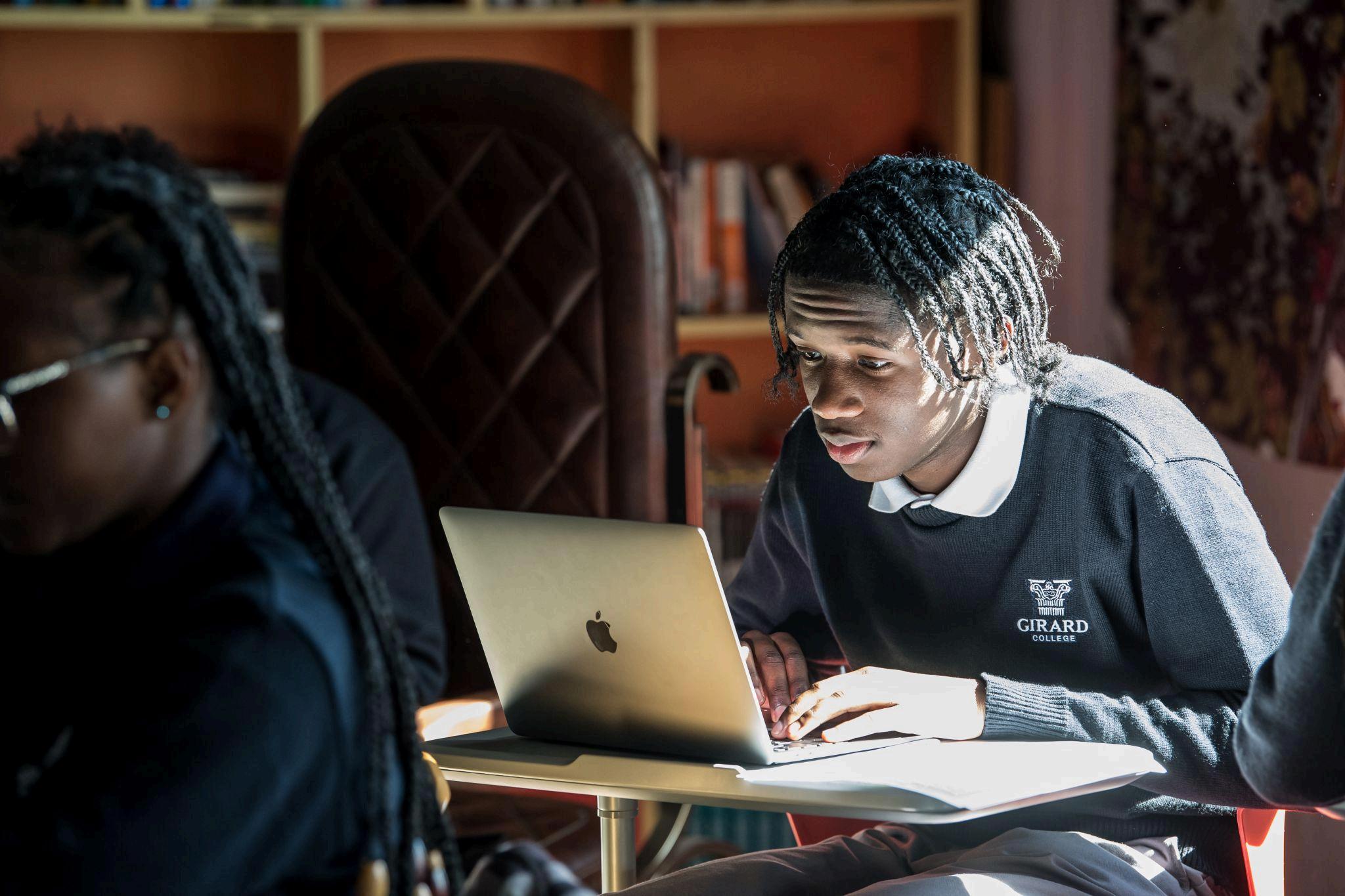
Freedom & Civil Liberties: Unpack the fundamental freedoms guaranteed to all Americans in the Bill of Rights. Learn ways people can become American citizens and government immigration policies. Discuss the history of discrimination and the steps the government has taken to address that problem Analyze the role of the People in government through the history of voting rights, public opinion, polling and special interest groups. Understand political parties and the way elections work in the US including the electoral college and the role of money.
Government & the Economy: Analyze the role played by the government in the economy of the US and in countries around the world
State and Local Governments: Analyze state and local governments and all that they do on a daily basis for their state.
By the end of high school at Girard College a student will be able to say:
“I can explain European imperialism’s effects on Africa and the Americas.”
“I understand the causes, course, and consequences of World War I and II.”
“I can discuss the impact of disenfranchisement and how Jim Crow laws played a role in enforcing racial segregation and discrimination.”
CAREER & POST-SECONDARY EDUCATION
Grade 9
Career Awareness and Exploration: Explore how career choices align with education and training options, as well as opportunities in the community and workforce
Employability Skills: Use critical thinking, teamwork, and professional communication while applying technology and managing projects effectively; understand formal documentation needed to work.
Growth and Advancement: Learn how to set goals, reflect on progress, and build work habits that support learning and future plans.
Personal Interests and Career Planning: Connect interests, strengths, and achievements to potential career options while building a draft career plan.
Post-Secondary Education: Explore different post-secondary options, connect interests to possible careers and understand why education after high school is
Grade 10
Career Awareness and Exploration: Analyze how career choices connect to education pathways and how outside factors like job growth and earnings impact employment
Employability Skills: Apply professional etiquette and effective communication while using critical thinking to solve problems in team settings; gather formal documentation needed to work; draft a resume.
Growth and Advancement: Develop strategies for managing transitions and using feedback to improve skills for personal and career growth.
Personal Interests and Career Planning: Evaluate career options based on interests and strengths and refine a career plan with actionable steps.
Post-Secondary Education: Research post-secondary pathways, align academic plans with future goals and learn about admissions and financial aid
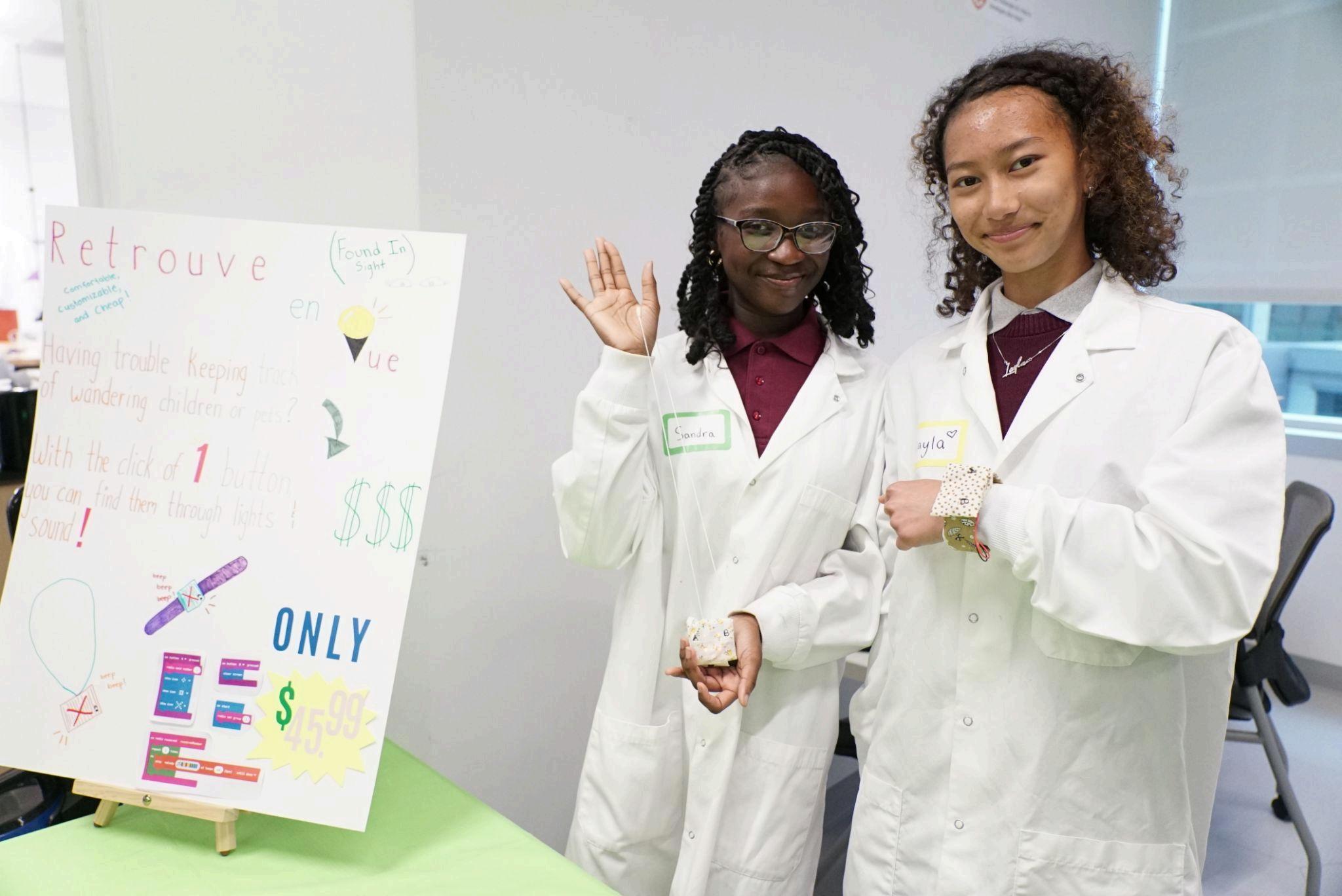
Grade 11 Grade 12
Career Awareness and Exploration: Examine how to prepare for a career by exploring in-demand occupations and understanding workplace rights and responsibilities.
Employability Skills: Demonstrate collaboration, problem-solving, and the use of job-specific technologies to complete work responsibly; prepare for interviews and formal documentation needed to work; apply for part-time jobs.
Growth and Advancement: Identify resources and strategies to continue learning new skills and transitioning successfully between education and career opportunities.
Personal Interests and Career Planning: Research and evaluate career paths while developing tools to market themselves as job candidates.
Post-Secondary Education: Prepare for college and training applications by taking tests, exploring campuses, drafting resumes and essays, and learning about financial aid
Career Awareness and Exploration: Analyze choices with respect to training pathways, job outlook, and employment conditions to make informed career decisions.
Employability Skills: Apply entrepreneurial thinking, professional communication, and effective use of technology in academic and settings; revise and update formal documenta needed to work. Build an online presence on professional platforms like LinkedIn.
Growth and Advancement: Practice reflectin work habits and feedback while planning for t transition from high school to college, training, work.
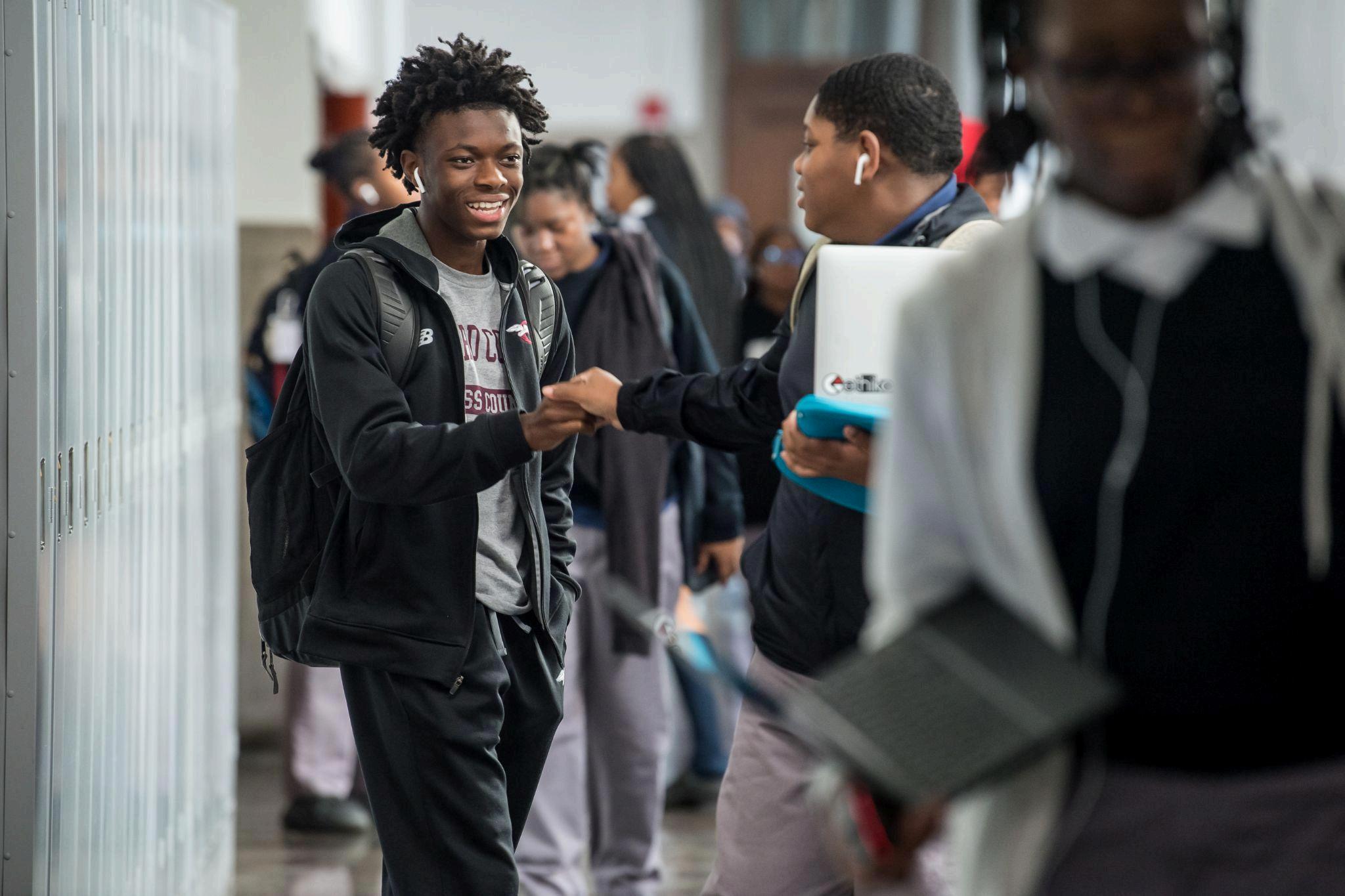
Personal Interests and Career Planning: Connect with people in their field of interest and participate in online discussions Attend networking events, conferences, or clubs related to their interests or career aspirations. Finalize a career plan aligned with interests and strengths, outlining specific next steps toward a chosen career path
Post-Secondary Education: Complete applications, compare financial aid packages, accept an offer, and prepare for the transition to post-secondary education or training
By the end of high school at Girard College a student will be able to say:
“I participated in elective courses and after school clubs that matched my interests.”
“I can write a resume and cover letter tailored to a part-time job or internship aligned with my interests.”
“I can create a personal action plan for post-graduation goals, including steps for skill-building and job readiness ”
“I have a post-secondary plan that includes enrolling into a college, work, or training program.”
“I feel ready to persevere through challenges because of my strong work and study habits.”
LIFE SKILLS
Grade 9 Grade 10
Self Care: Has a self care routine, maintains general cleanliness and hygiene routines. Learn about healthy sleep habits and maintaining a regular sleep schedule Understand sexual health, pregnancy prevention, STDs and setting boundaries. Is familiar with common illness symptoms, such as fever, cough, and body aches and seeks medical attention. Know the importance of engaging in regular physical activity or exercise for at least 30 minutes a day
Daily Living: Independently maintain a clean living space including laundry. Understand various cooking methods like baking, frying, grilling, boiling, and sautéing. Know when to use each method and how to substitute ingredients when necessary due to allergies, dietary restrictions or ingredient unavailability. Sets deadlines and a plan to tackle responsibilities and commitments Know general home maintenance (install/test smoke, carbon monoxide detectors and assembling furniture). Can navigate public transportation options (bus/train/regional rail) and maps Make informed decisions about the use of vaping, drugs and alcohol and know how to seek help to support quitting.
Communication: Communicate feelings honestly and assertively, without blame or aggression. Use basic social graces and know how to behave in different situations Is aware of body language and knows how to maintain good posture and avoids crossing the arms.
Academic and Digital Preparedness: Develop time management skills (avoiding procrastination, eliminating distractions) to balance school, extracurricular activities, and personal time. Set personal goals for high school while building confidence about the future Complete school work and have a study routine to maintain achieving grades. Keep everything neat and organized. Learn the role of digital media in daily life, the benefits and drawbacks of online tracking, how to respect the privacy of others online, spotting when an online relationship is risky, how to act with empathy and positivity when online and avoiding fake videos and information online.
Civic Engagement: Help in the community and share ideas responsibly through surveys, town halls, letters, proposals, petitions and using social media
Social Relationships: Practice empathy and resolving conflict by actively listening, understanding others’ perspectives and offering support Learn to say “no” assertively to peer pressure that goes against personal values. Spend time with friends who support well-being.
Self Care: Has a self care routine that includes healthy sleep habits and regular physical activity. Make informed decisions about sexual activity, seek guidance from healthcare professionals and know sexual violence prevention methods. Establish a regular sleep schedule and create a relaxing bedtime routine. Learn about preventive measures such as vaccinations, regular check-ups, and screenings for health conditions Identify sources of stress and practice stress management techniques such as deep breathing, meditation, or yoga.
Daily Living: Revisit the importance of a balanced diet that includes limited processed foods. Practice portion control and mindful eating. Open a checking/savings account, budget allowance or part-time earnings, and save for personal goals. Know basic home maintenance (resetting circuit breakers, turning off water/gas shut off valves, shutting off water to fixtures). Understand the steps for obtaining a driver’s license, study the manual, and prepare for the written test. Make informed decisions about vaping, drugs, and alcohol use, and knows how to seek help for quitting
Communication: Know how to maintain appropriate eye contact to convey confidence and attentiveness Avoid staring or looking away too frequently Know how to show they’re engaged by nodding, making eye contact, and providing verbal cues like “I see” or “That’s interesting.”
Academic and Digital Preparedness: Learn time management skills (setting priorities, time blocking, planning ahead) to balance school, extracurricular activities, and personal time Complete school work and have a study routine to maintain achieving grades and academic progress. Reflect on progress toward goals and develop a vision for adulthood. Learn how social media affects how a person feels, the privacy risks of new tech, creating a social media presence that represents them well, ensuring online relationships are healthy and positive, how to counter online hate speech and xenophobia and how to challenge their own confirmation bias
Civic Engagement: Participate in positive actions in the community (i e community service, advocacy rallies, and mock election/debates).
Social Relationships: Build and maintain healthy relationships with friends and family members who provide emotional support. Acknowledge mistakes, take responsibility and offer a genuine apology.
Grade 11
Self Care: Practice a self-care routine with healthy sleep, regular exercise, and stress management techniques like gratitude and positive self-talk Make informed decisions about relationships and sexual activity, seeks healthcare guidance, and schedules regular health check-ups.
Daily Living: Understand basic nutrition and make healthy food choices. Know general home maintenance (patching walls, painting and caulking) Have a valid driver’s license and know car ownership requirements (registration, car insurance and annual inspections). Make informed decisions about the use of vaping, drugs and alcohol and know how to seek help to support quitting.
Communication: Learn to trust intuition Know how to approach people with a friendly demeanor. Practice small talk using open-ended questions and know how to gracefully end a conversation with gratitude.
Academic and Digital Preparedness: Practice time effectively between school, activities, and personal life with tools like calendars and to-do lists. Maintain a study routine and connect strengths to future plans Learn how devices can be addictive, age appropriate use of social media, how information posted can impact future opportunities, use code-switching to enhance communication with online audiences, how online disinhibition sometimes leads to cyberbullying and how internet ads contribute to the spread of misinformation
Civic Engagement: Advocate for important issues by educating peers, forming advocacy groups, organizing campaigns, and engaging with elected officials.
Social Relationships: Learn how to build and maintain healthy relationships with friends and family for mutual emotional support Recognize manipulative behaviors and set boundaries with individuals who engage in such actions.
Grade 12
Self Care: Follow a self-care routine with he physical activity, and mindfulness exercises stress Make informed decisions about sexu seeks healthcare guidance, and practices se and reflection.
Daily Living: Plan a balanced diet and stay h how to secure safe housing, manage utility s plan transportation Maintain essential vehic and handle emergencies like tire blowouts o overheating. Make informed decisions abou and alcohol and know where to seek help
Communication: Know public speaking and presentation skills, including content organization, audience engagement, and body language. Provide and receive constructive feedback, and follow up with emails after meetings to express appreciation.

Academic and Digital Preparedness: Manage time effectively with tools like calendars and to-do lists, balancing school, activities, and personal life. Keep work organized and maintain a study routine to achieve good grades. Prepare a brief introduction of themselves. Learn the health effects of screen time, government access to social media and cellphone data, creating a digital footprint that showcases purpose, how to communicate civility online, the consequences of online hate speech and how filter bubbles limit the information we’re exposed to
Civic Engagement: Register to vote and understand civic responsibilities including knowing when voting happens locally, statewide and nationwide. Know the best places to get accurate information to be informed
Social Relationships: Maintain healthy relationships with friends and family for emotional support Seek advice from trusted adults when making decisions and offer support in return.
By the end of high school at Girard College a student will be able to say:
“I can schedule a doctor’s appointment and I understand the basics of health insurance.”
“I know how to make a social presence that represents me positively
“I have a valid driver’s license and know how to use a GPS.”
“I’ve secured housing for after graduation and know how to search for housing when I need it.”


FAREWELL SONG
Sixteen hundred looking on, we are in the van, We have run our marathon as noble as we can. Out beyond the open gate, lights of promise glow; You who cheered us when we came, bless us ere we go.
Chorus
Farewell! Farewell! Dear temple on the hill, We’ll not forget you till our hearts be still. We shall miss the daily round, victory at ball, Miss the gay parade, and miss classmates most of all. Only Love illumes the years, classmates pass it on, Light the torch and spread the flame till the years be gone.
Sixteen hundred looking on, follow, follow hard, Fight the game, increase her fame, goodbye to old Girard. There's a world of worth beyond, students must not lag, Where good fortune waits for us, ’neath the starry flag.
